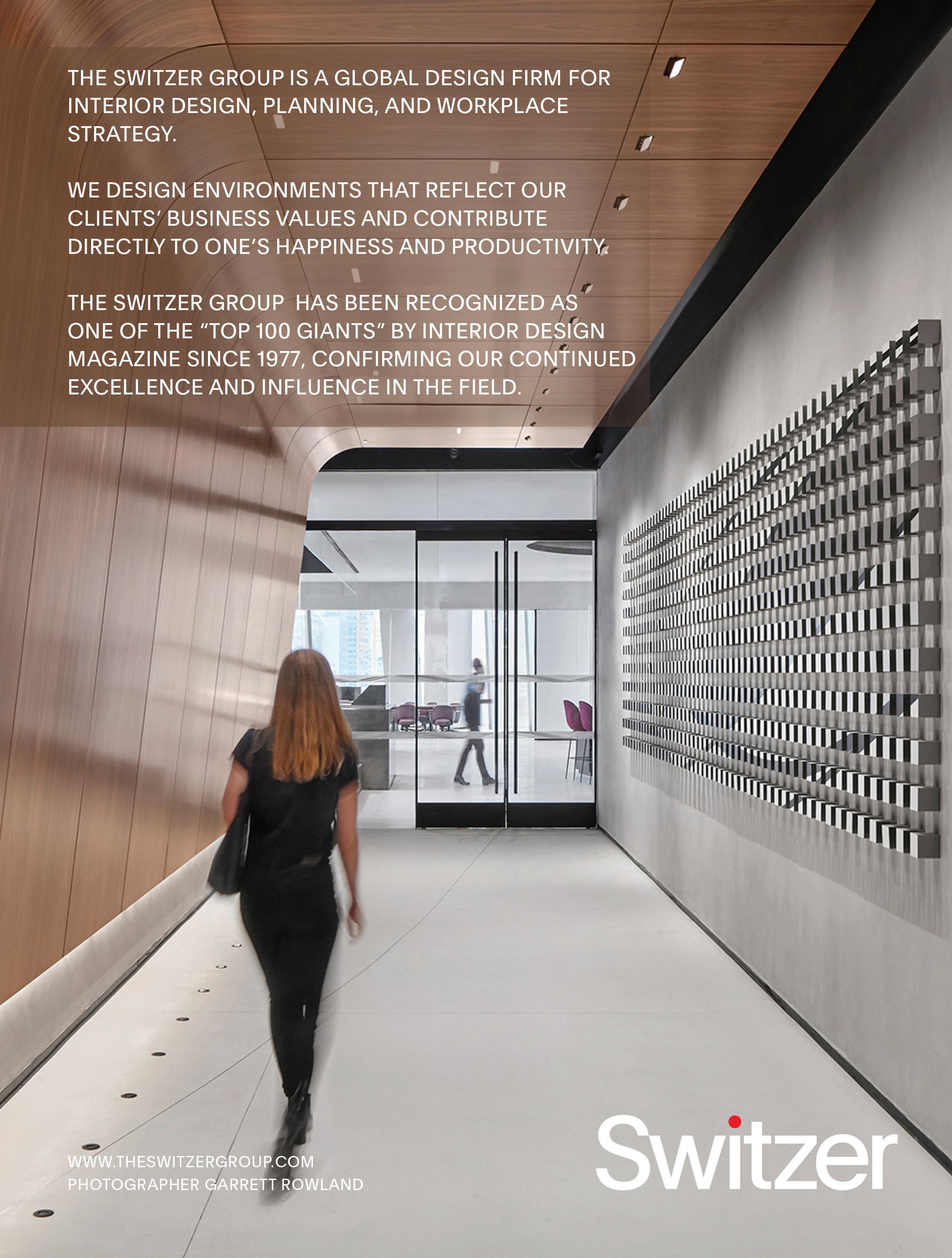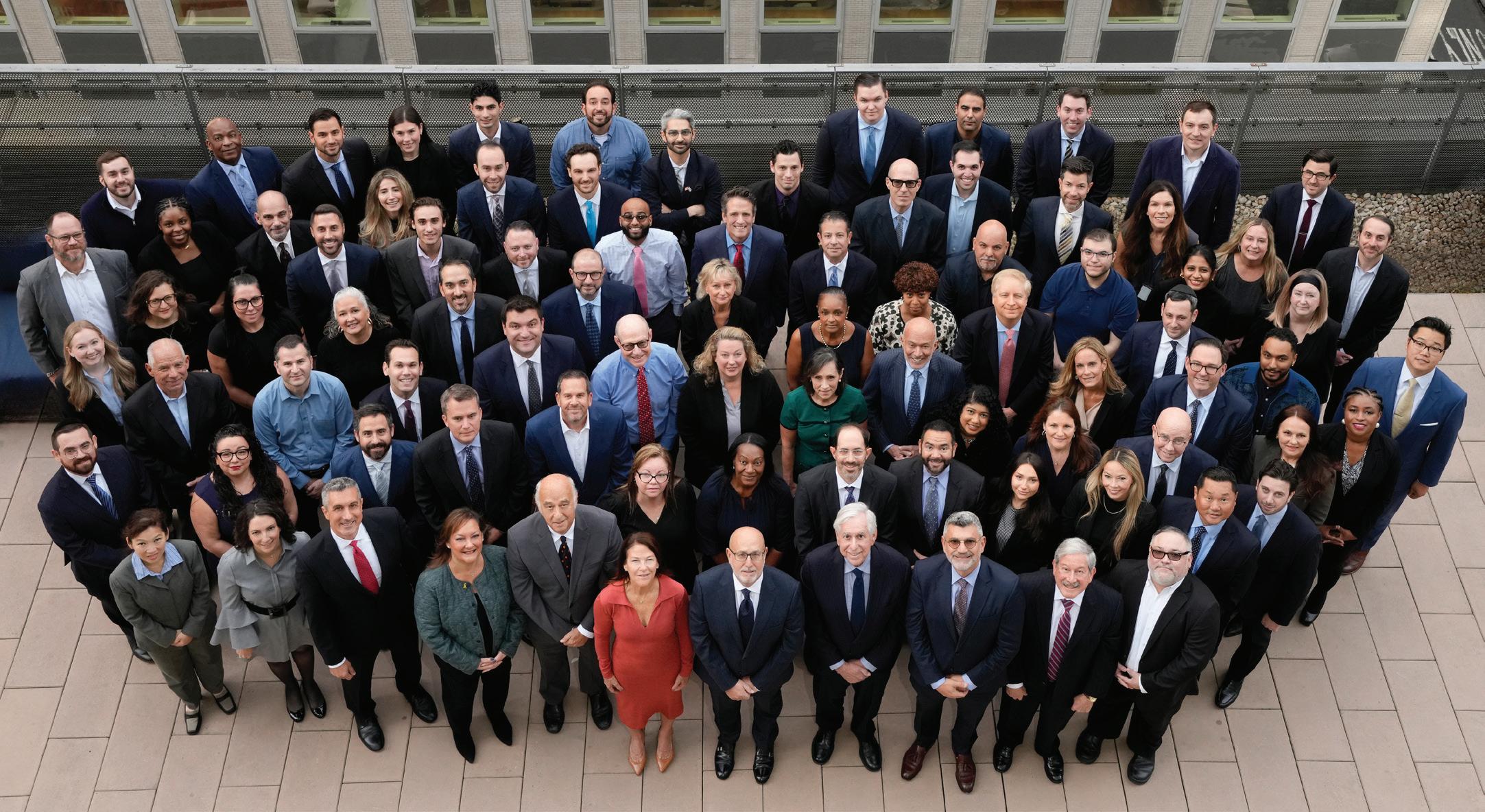
























































50 Years at the Forefront of New York City’s Real Estate Industry Managing Member Michael E. Lefkowitz and Founder Gary M. Rosenberg





In shifting markets, we’re taking the long view, so you can seize the moment — now and for years to come.
































EDITORIAL
Editor
Debra Hazel
Associate Editor
Alex Baumbusch
Director of Communications and Marketing
Penelope Herrera
Director of
Newsletter Division
Cheri Phillips
PRESIDENT/CEO
Jeff Mann
ART
Art Director
Serena Bhullar
Cover Photography
Rosenberg & Estis
Jared Antin
Andy Birch
Frank DeLucia
Ran Eliasaf
Kris Kiser
Andrew Schwartz
George Shea
Carol A. Sigmond
Stephen Smith
Technology Consultant
Joshua Fried
Distribution
Mitchell’s Delivery Service
DIGITAL MEDIA
Designers
Serena Bhullar
Editors
Alexandra Baumbusch
Natalia Finnis-Smart
Debra Hazel
Penelope Herrera
Cheri Phillips
Web Developer
CS Designworks
West Coast Office: 578 Washington Blvd., Suite 827
Marina Del Rey, CA 90292 866-306-MANN (6266) mannpublications.com



East Coast Office: 450 7th Ave, Suite 2306
New York, NY 10123 212-840-MANN (6266)





For 50 years, R&E's attorneys have been instrumental in driving the firm's success, helping R&E achieve remarkable milestones and putting the firm at the forefront of the real estate industry.




























































Welcome, 2025, and welcome back, readers!
I hope you’ve enjoyed the holidays and a bit of time off. We’re back in full swing, and I’m thrilled to start the year with a cover feature on a law firm that continues to evolve with the times and its clients.
Rosenberg & Estis is celebrating its 50th anniversary this year, but also is celebrating a new division, adding a practice dedicated to distressed assets on top of its work in every other aspect of real estate law. The firm has worked with small and major landlords, helping to create case law that affects us all. It’s a fascinating read.
It’s also a pleasure to see the many events that took place as 2024 came to a close, especially those that help those in need. We’re proud to feature Children’s Happy Faces Foundation, American Friends of Rabin Medical Center and Town Title Insurance Agency’s fundraisers, as well as events that help to educate us and honor us.
January is always a time for resolutions, and this year, we at Mann Publications will renew our annual resolution: to provide you with the information you need and want to help you do business better, in our magazines and news wires. Please let us know how we can help you.
Happy New Year!

“Foresight is not about predicting the future, it’s about minimizing surprise.” — Karl Schroeder














































































It’s a new year, with new opportunities in real estate.
The annual PwC/Urban Land Institute report on “Emerging Trends in Real Estate,” offers a snapshot of how the organization’s members feel the year is going to play out. As you’ll see in our summary, one of the most appealing sectors — data centers — is also one of the most difficult to build because of its intense need for power and water for cooling. It will be fascinating to see how builders meet this challenge as we need ever more cloud storage for routine and complicated tasks.
Meanwhile, Jared Antin of Elegran/Forbes Global lets us know why Manhattan’s residential real estate prices are cointinuing to rise, and Stephen Smith tells us how various technologies can make our homes smarter and healthier. Also check out our columnists, who share their expertise on financing trends, energy standards, the importance of mixed-use and more.
This year looks to be one of massive change, and we’ll be here to tell you what’s happening and why. I’m looking forward to your suggestions and contributions.




Zetlin & De Chiara LLP, one of the country’s leading law firms, has built a reputation on counseling clients through complex issues. Whether negotiating a contract, resolving a dispute, or providing guidance to navigate the construction process, Zetlin & De Chiara is recognized as a “go-to firm for construction.”



Photos by Brooke Alexander
Over 450 leaders of New York’s and America’s real estate, finance and technology industries joined together at The Plaza Hotel in New York City for the American Friends of Rabin Medical Center (AFRMC) 24th Annual Gala to support saving lives in Israel at Rabin Medical Center, the country’s premier hospital.
The Yitzhak Rabin Corporate & Civic Responsibility Leadership Award was presented to Bank of America, represented by Sheri Bronstein. Robert J. Sorin, a partner at Fried Frank, was honored with the Yitzhak Rabin Lifetime Real Estate & Legal Leadership Award and the Yitzhak Rabin Lifetime Real Estate Leadership Award was given to Bruce E. Mosler, chairman, global brokerage of Cushman & Wakefield. Honorees were recognized for their “outstanding leadership in their fields and for being trusted partners, loyal friends and exemplary philanthropists.”
AFRMC Gala Chairs Scott Rechler, Shari Redstone, Orly Avidan, Gary Jacob, Mitti Liebersohn, Mitchell Moinian, Wendy Mosler, Mitchell Rudin, John Santora, Stephen Siegel, Harrison Sitomer and Glen Weiss contributed to the event’s success in raising critical funds for Israel’s Rabin Medical Center’s Emergency Rehabilitation Department for wounded Israeli soldiers and civilians. Since October 7, 2023, the hospital has been treating countless casualties — including returned hostages, children and women — and is one of the only hospitals in Israel with a rehabilitation program dedicated specifically for recovering war casualties.
Guest presenter Shari Redstone (chair, Paramount Global and president and CEO, National Amusements) introduced the 13th Prime Minister of Israel, Naftali Bennett, who once again joined Gala Master of Ceremonies – her seventh year – Magalie Laguerre-Wilkinson, vice president of news programming at Nickelodeon News, in a fireside chat. Bennett spoke of his recent visit to Israel’s Rabin Medical Center and how he wished that the country would “respond the way Rabin Medical Center did — with a sense of community and collective purpose to help others.”
At the end of the evening, RXR CEO Scott Rechler presented a gift of thanks to Bennett, and AFRMC Executive Director Joshua Plaut announced three Rabin Medical Exchange Fellowships to be named after the evening’s honorees.







by Jill Lotenberg and Howard Wechsler
The Children’s Happy Faces Foundation had a special day at its yearly charity golf and tennis experience, held at Sleepy Hollow Country Club in Briarcliff Manor, New York, and Fenway Golf Club in Scarsdale, New York to benefit Ronald McDonald House New York. Golfers at Sleepy Hollow, overlooking the Hudson River, were greeted with a bluegrass band and omelets. In total, 230 golfers and tennis players and an additional 200 donors gathered for dinner at the Mansion of Sleepy Hollow Country Club, enjoying live music by the Parker Reilly Band and the American Bombshells.
“The continued support from the New York real estate industry that directly benefits Ronald McDonald House New York is truly remarkable,” said David Lipson, CEO and founding member of Children’s Happy Faces Foundation and senior managing director of Century Management Services Inc., the event’s chairman. “For 45 years, Ronald McDonald House New York has provided needed support for the children and their families, with an incredible staff and dedicated volunteers offing daily programs for the children and their families. It’s truly their home away from home — the house that love and hope built on the Upper East Side of Manhattan, centrally located near the finest hospitals in the world, ensuring that families can be with their children while undergoing care. It is wonderful to see such an outpouring of love and support from so many.”
This vital fundraiser was supported by several notable organizations. The Title Sponsor was The Barry Family Foundation. The Platinum Sponsor was the Andrew & Abby May Family Foundation. Gold Sponsors were Century Management Services Inc., Efficient Combustion & Cooling Corp., Morgan Stanley, National Cooperative Bank and Spring Scaffolding LLC.
Silver Sponsors were Bargold Storage Systems, JAD Corporation, C.A.C. Industries and Skyline Restoration. Bronze Sponsors were Daniels Norelli Cecere & Tavel PC and Dial-ABug Pest Control. Brass Sponsors were Mann Publications, New York Plumbing & Heating Corp. and Schwartz Sladkus Reich Greenberg & Atlas.
“We are grateful to the Children’s Happy Faces Foundation and all who have partnered with us to bring this year’s golf outing to life,” said Ruth C. Browne, president and CEO of Ronald McDonald House New York. “The funds raised for this event are critically important in supporting our families as they experience the most difficult fight of their lives.”
Children’s Happy Faces Foundation’s mission is to assist the families of sick children during the difficult and challenging times they face. Over a 17-year period, the foundation has raised a total of $10 million.
















Town Title Agency hosted its Ninth Annual Town Title Golf Outing, presented by the Town Title Foundation, at the prestigious Ridgewood Country Club, in Paramus, New Jersey. With its renowned 27-hole private golf course and a clubhouse designed by A.W. Tillinghast and Clifford Wendehack, Ridgewood Country Club gave attendees a day of exceptional golfing in a stunning setting.
This year, all net proceeds from the golf outing benefited three extraordinary programs at Hackensack University Medical Center, including the Inserra Diabetes Research Institute, Tackle Kids Cancer at the Children’s Cancer Institute at the Joseph M. Sanzari Children’s Hospital and the Caryl and Jim Kourgelis Foundation for
Behavioral Health. These programs are dedicated to pioneering research, providing cutting-edge treatment and offering compassionate care in their respective fields.
Town Title Agency is a full-service title insurance agency founded in 2002. It is the agent for Chicago Title Insurance Company, First American Title Insurance Company and Stewart Title Insurance.
The Town Title Foundation is a 501(c)(3) nonprofit organization supporting local communities. Its mission includes providing financial aid to the healthcare community, fostering small businesses, supporting local organizations and enhancing educational systems.






The Schack Real Estate Club held its second annual Schack Student Summit at the Rosenthal Pavilion at the Kimmel Center for University Life at 60 Washington Square South. The exciting day was filled with insightful panels, fireside chats and networking opportunities with top professionals from the real estate industry. This summit is designed to provide students with the chance to learn from and engage with leading experts across various sectors as they share their experiences, offer valuable insights and discuss the latest trends, shaping the future of real estate.
Speakers included Peter Lewis from Wharton Equity Partners, Robert Verrone from Iron Hound, Doug Harmon from Newmark, Miki Naftali from the Naftali Group, Kevin Maloney from PMG and NYU Schack Alumni who generously shared their time and insights.





The Real Estate Board of New York hosted its Annual Commercial Holiday Luncheon at The Metropolitan Club in New York City. More than 200 professionals attended the annual event, which gathers the trade organization’s members working in office and retail leasing, development, investment sales and other sectors of the business.
Following a lively cocktail hour, guests enjoyed a lunch featuring remarks by REBNY COO Sandhya Espitia, followed by a fireside chat between Blackstone Global Co-Head of Real Estate Kathleen McCarthy and Commercial Observer Executive Editor Cathy Cunningham. REBNY’s Most Promising Commercial Salesperson of the Year Award (Rookie of the Year) was announced at the luncheon and presented to Cooper Katz of ABS Partners Real Estate and Claire Koeppel of Newmark. Created in 1996 and selected by REBNY’s Commercial Board, this award recognizes current and potential professional achievement as well as high character and ethical professional behavior.
















$995/YEAR
$995/YEAR MEMBERSHIP
Be a part of the who’s who in real estate while listening to guest speakers, enjoying an assortment of food and drinks and having a good time.
Be a part of the who’s who in real estate while listening to guest speakers, enjoying an assortment of food and drinks and having a good time.
Be a part of the who’s who in real estate while listening to guest speakers, enjoying an assortment of food and drinks and having a good time.
Be a part of the who’s who in real estate while listening to guest speakers, enjoying an assortment of food and drinks and having a good time.
A space where members can meet, connect, and work together to help real estate prosper more than ever
A space where members can meet, connect, and work togethertohelprealestateprospermorethanever
A space where members can meet, connect, and work togethertohelprealestateprospermorethanever
A space where members can meet, connect, and work togethertohelprealestateprospermorethanever
We hope you see the vision of filling NYC with an abundance of success
WehopeyouseethevisionoffillingNYC withanabundance ofsuccess
WehopeyouseethevisionoffillingNYC withanabundance ofsuccess
WehopeyouseethevisionoffillingNYCwithanabundance ofsuccess
In a transaction arranged by CBRE, Kozusko Harris Duncan LLP (KHD), an international law practice representing highly successful individuals, private businesses and family offices, has inked a 14,701-square-foot office lease at 575 Madison Ave. The law firm will expand its operations already at the property and will relocate from the 24th floor, where it occupies 8,629 square feet, to part of the 12th floor of the owneroccupied, 25-story office tower.
CBRE’s Chris Mansfield, Zac Price and Tara Rhodes represented KHD. The CBRE team of William Hooks, David Hollander, Gregg Rothkin, Bradley Auerbach and Maxwell Tarter are exclusive leasing agents for the property.
“We are thrilled to have negotiated a new lease that allows KHD to expand its footprint in the property as it continues to grow its client base,” said Price. “575 Madison Ave. offered very attractive economics for a building so well located. Ownership has done an excellent job modernizing the building and we appreciated collaborating with ownership to achieve such a great outcome for KHD.”
The building, located on the corner of 57th Street and Madison Avenue, has completed a renovation, including a new lobby and amenity center.

ZCG, a privately held merchant bank in the midst of a strategic global expansion, has leased the entire 16,849-square-foot 16th floor at 430 Park Ave., announced JLL, which represented ownership. The 19-story, Class A office property occupies an entire city block between East 55th and East 56th Streets.
The company will relocate from 1330 Avenue of the Americas, where it occupied 10,000 square feet, in the second quarter of 2025 after its turnkey space has been fully built out by ownership.
“Our new office at 430 Park Ave. reflects ZCG’s commitment to New York as a key hub for our global operations,” said James Zenni, founder, president and CEO of ZCG. “As we continue to expand our team and presence worldwide, this location will support our ongoing growth and our ability to deliver excellence for our partners and investors.”
430 Park Ave. was repositioned in 2002 as a Class A office property by current ownership — a joint venture of Oestreicher Properties, Midwood Investment & Management and Marx Realty — and serves as home to a high-profile roster of corporate and financial tenants, including SK Capital Partners, H.C. Wainwright and Withers.
Ownership recently retained architectural firms MdeAS Architects and Vocon to design new base building improvements that will include a new lobby and entrance on Park Avenue, where net effective rents have continued to climb post-pandemic.
“Vacancy on Park Avenue has been falling as the flight to quality continues among tenants seeking proximity to regional transit,” said JLL Executive Managing Director Clark Finney. “With its institutional, hands-on ownership, 430 Park Ave. is well positioned to meet persistent demand for Class A office space in this prime Manhattan location.”
Finney, along with JLL Vice Chairman Frank Doyle, Managing Director Randy Abend and Senior Vice President Robin Olinyk represented ownership in the lease with ZCG. The tenant was represented by Josh Berger and Sam Matayev of Norman Bobrow & Company Inc.



The Jewish Museum 26th Annual Most Amazing New York Art & Design Tour
Brilliant Earth Group Inc., a specialist in ethically sourced fine jewelry, has opened its first street-level showroom in New York City at 255 Elizabeth St. in Nolita. The company now has four retail locations in the New York Metropolitan area.
The floorplan includes a jewelry try-on bar, offering customers a handson shopping experience, and includes dedicated private spaces for the company’s one-on-one bridal and fine jewelry appointments. Brilliant Earth’s engagement rings will be available for customers interested in immediate purchases, alongside design-your-own pieces.
“We are committed to serving our customers where they live and shop, ensuring that our personalized and joyful shopping experience is always within reach,” said Beth Gerstein, co-founder and CEO. “Opening our doors in this vibrant Nolita neighborhood, particularly during the holiday season, is an exciting step forward for us, and we look forward to serving this dynamic community.”
The opening of the Nolita showroom provides customers in the greater New York Metropolitan area with two convenient options in Manhattan, along with additional locations in Brooklyn and at the Roosevelt Field Mall on Long Island.
“This new location is an important milestone in our brand’s evolution,”
said Chief Brand Officer Pam Catlett. “We’re delighted to bring our distinct bridal, wedding and fine jewelry collections to more consumers. We are thrilled to be in this vital New York City neighborhood that’s always been a center of style and self-expression.”
UJA-Federation of New York’s Hospitality Division Honors Ian Schrager

Dalfen Industrial has signed a 96,000-square-foot lease with HVAC equipment company Cooper & Hunter at its recently completed Midpoint Miami Logistics Center in Hialeah, Fla. Cushman & Wakefield negotiated on behalf of the landlord.
Midpoint Miami Logistics Center is a recently completed, Class A development totaling 300,000 square feet. This development is located in the NW Medley industrial submarket of Dade County with close access to the Florida Turnpike, Interstate 75 and West Okeechobee (Hwy. 27). It is also within 11 miles of Miami International Airport and 20 miles of the Port of Miami.
Wayne Ramoski, Skylar Stein and Ivana Leitner Perez of Cushman & Wakefield represented Dalfen Industrial in the lease transaction, while Cooper & Hunter (operating under the name Comfortside) was represented by Cook Commercial Realty.
“We are pleased to welcome Comfortside to our Midpoint Miami Logistics Center,” said Tyler McElroy, Dalfen Industrial’s Florida market officer. “This strategic ‘last mile’ location will provide Comfortside with an ideal location for their immediate Miami distribution needs.”
Dalfen Industrial owns and operates 1.5 million square feet of industrial property in South Florida.





Century 21 Real Estate is expanding its international presence with signings of three new Master Franchise Agreements in Greece, India and the United Arab Emirates (UAE), tapping into the growing markets in each of these countries.
Antonios Kallas and his two sons, Yannis and Athanasios, will oversee the development of the Century 21 network in Greece, further expanding its current base of operations of three offices and 50 independent agents. According to Global Property Guide, Greece is experiencing strong housing market trends including increased demand from foreign homebuyers, more residential construction activity and continued economic growth.
“Our affiliation with Century 21 Real Estate in Greece marks a significant milestone for both our company and the real estate industry in the region,” said Antonios Kallas. “This new venture reflects our commitment to bringing world-class real estate services and innovative practices to the Greek market, building on the strong foundation and global reputation of the Century 21 brand.”
Charles Tarbey, owner of Century 21 Australia/New Zealand, will oversee the new Master Franchise Agreements in India and the UAE.
Global Property Guide data indicates residential property sales in the UAE are expected to increase by nearly 18% over the next five years, from $390 billion in 2024 to $460 billion in 2029. Among the primary drivers of growth is a surge in demand for luxury properties due to an increase in high-net-worth individuals seeking investment opportunities.
He recognized an opportunity to leverage existing connections between

his current markets and these new countries, which will support the expansion of the Century 21 brand in all four regions.
“Over recent years, many hard-working people from India and the UAE have made Australia and New Zealand their home,” explained Tarbey. “Securing the rights to operate Century 21 India and Century 21 United Arab Emirates will allow us to directly support this growing relationship by establishing a direct business relationship that will support the high level of interest in property ownership across all of these two countries.”
India’s real estate market outlook is also strong, with stable mortgage interest rates serving as the main drivers. In addition, increasing demand (particularly for high-value properties) and a surge in new development is contributing to a growing real estate market.
Corcoran Group LLC announced its first Mexican franchise with the launch of Corcoran The Baja Real Estate Co. Owned and led by Blake Harrington, the brokerage will serve clients throughout the greater Cabo San Lucas area.
“Cabo San Lucas is a vibrant destination and a global leader in tourism, luxury, and culture — the perfect market for the Corcoran® brand’s expansion into Mexico,” said Pamela Liebman, president and CEO of The Corcoran Group. “With Blake’s extensive experience and his resounding influence within the local market, we’re excited to grow our global presence and showcase everything the Corcoran brand has to offer both consumers and real estate professionals throughout Cabo.”
Harrington has been a leader in the luxury Cabo San Lucas real estate market since co-founding REmexico Real Estate in 2010. Following the success of REmexico Real Estate, Harrington moved on to become vice president at Snell Real Estate, a Baja California Sur brokerage, where he led the company in surpassing $1 billion in sales volume.
Cabo San Lucas draws interest from both domestic and international consumers with its blend of luxury resorts, pristine beaches and vibrant nightlife. Nestled at the southern tip of the Baja Peninsula, Cabo offers a thriving tourism economy and world-class development opportunities, with residential real estate options ranging from convenient beachfront condominiums to custom estates in private communities.
The area is renowned for its top-tier golf courses, bustling tourism

corridor, sprawling beaches and numerous outdoor activities, generating high-demand for vacation homes, investment properties and primary residences for those interested in living the resort life all year long.
With an international airport and easy access to major U.S. cities, Cabo continues to be a dynamic hub for consumers seeking leisure and real estate development.
In addition to Harrington, Corcoran The Baja Real Estate Company is comprised of a boutique team of agents and support staff, and will operate out of their newly established office, located at Calle Boulevard Mijares No. 32 in San Jose del Cabo, Baja California Sur, Mexico.
Photo via PRNewswire

Florida’s housing market in October reported higher inventory levels (active listings) and easing statewide median prices compared to a year ago, according to Florida Realtors’ housing data.
“With more inventory available now and home price increases slowing, it’s a positive sign for homebuyers, who are seeing more opportunities to enter the market,” said 2024 Florida Realtors President Gia Arvin, broker-owner with Matchmaker Realty in Gainesville. “Mortgage interest rates are lower than they were a year ago, too, which helps boost affordability.”
In October, closed sales of existing single-family homes statewide totaled 18,671, down 5.6% year-over-year; existing condo-townhouse sales totaled 6,499, down 19.9% over October 2023, according to data from Florida Realtors Research Department in partnership with local Realtor boards/associations.
The statewide median sales price for single-family existing homes in October was $415,000, up 1.2% from $410,000 one year earlier. For condo-townhouse units, the median price was $315,000, down 2.2% from $321,990 in October 2023.
According to Florida Realtors Chief Economist Brad O’Connor, Hurricane Milton caused significant coastal damage in Florida, from Tampa Bay down well to the south along the Gulf Coast. While inland areas were spared from catastrophic winds due to Milton’s weakening ahead of making landfall on October 9, 2024, the storm still caused widespread

corridor, including in the Orlando area.
On the supply side of the market, Florida had a 4.7-month supply of single-family existing homes last month, up 34.3% year-over-year. For condo-townhouse units, the state had a 7.7-month supply in October, up 67.4% year-over-year.
Related Group and Integra Investments have broken ground on The St. Regis Residences, Miami (The Residences), the residential tower rising at 1809 Brickell Ave. on the Biscayne Bay waterfront in Miami’s South Brickell neighborhood. Featuring 152 bespoke residences — including penthouses, sky villas and two exclusive stand-alone garden villas — the project offers the timeless elegance and celebrated five-star services that define the St. Regis brand.
Coastal Construction is overseeing construction, and completion is expected in 2027.
“The groundbreaking for The St. Regis Residences, Miami marks a pivotal step in bringing an unparalleled luxury experience to one of South Florida’s most dynamic urban neighborhoods,” said Nick Pérez, president of Related’s condominium division. “With each milestone, we’re transforming the Downtown Miami skyline, introducing a level of sophistication and service that only the St. Regis brand can deliver.”
Architecture is by Robert A.M. Stern Architects (RAMSA) and interiors are by Rockwell Group. This striking property represents the first residential development in South Florida for RAMSA, which drew inspiration from the elegant aesthetic of golden-age ocean liners at sea, merged with the modern allure of skyscrapers.
“We’re proud to bring the St. Regis name to a premier site on the South Brickell waterfront,” said Nelson Stabile, principal at Integra. “Upon completion, this extraordinary property will offer buyers an elevated lifestyle unmatched in the area, blending hospitality-driven services with exceptional views and ease of access to the best of Downtown Miami.”

The amenities package comprises more than 50,000 square feet of indoor and outdoor spaces, including a professional-grade fitness center with a Pilates and yoga studio, a full-size pickleball court, a private marina, a world-class spa and holistic wellness center and an indoor lap pool. Signature butler services complete the lifestyle experience, including deliveries to residences, an on-premises house car, shoeshine service and other personal arrangements. Park-like grounds surround the building, with landscaping designed by the Swiss design firm Enea Garden Design.
Related Realty is the exclusive sales and marketing partner for The Residences.




StorageMart and Manhattan Mini Storage Third Party Management announced the onboarding of a new facility located at 41 East 21st St. that will operate under the Manhattan Mini Storage brand, adding to its growing portfolio in Manhattan. This additional self-storage facility, developed and owned by Mequity Companies, will be managed under StorageMart and Manhattan Mini Storage Third Party Management program.
StorageMart is a provider of self storage solutions with a presence across the continental United States, Canada and United Kingdom.
“Adding this facility to the Manhattan Mini Storage family is an exciting opportunity for us and for our partner, Mequity Companies,” said Herby Bowman, vice president of Third Party Management at StorageMart and Manhattan Mini Storage. “Our focus is on maximizing facility performance and enhancing service standards to match the exceptional reputation of Manhattan Mini Storage within the New York market.”
The facility offers 2,103 units and 65,165 net rentable square feet, providing convenient storage solutions tailored to both individuals and businesses in the Flatiron District. Designed with the needs of the community in mind, the facility includes entirely interior climatecontrolled units and a large, enclosed pull-in loading bay.
“Manhattan Mini Storage is the most dominant and recognizable storage brand in Manhattan and their portfolio performance has been outstanding,” said Mequity CEO Bill Marsh. “These factors compelled us to make the switch. The StorageMart team has done a great job on the transition.”
The StorageMart and Manhattan Mini Storage Third Party Management program is designed to provide self-storage owners and developers with operational, marketing and revenue management services.

Broad Street Realty has inaugurated a 2.4 MW(dc) rooftop solar project at its Cromwell Shopping Center in Glen Burnie, Maryland. The 233,000-square-foot shopping center is hosting the solar project, which produces enough electricity to power over 1,000 homes in BG&E service territory in Maryland. The ballasted racking system is covered by 4,380 solar panels.
“We are excited to be partnering with Centennial and MEI to decarbonize the Cromwell Shopping Center, advancing our goal to reduce emissions throughout Broad Street’s portfolio supporting our ESG initiatives,” said Michael Jacoby, Broad Street Chairman and CEO.
Centennial Generating Company developed the project, which was built by Halo, a solar engineering contractor; AccelDev served as development capital financing. The project will be owned and operated by Madison Energy Infrastructure (MEI).
“The solar project at Cromwell Shopping Center demonstrates how commercial real estate owners can implement solar projects with a clear and measurable benefit to their bottom line while achieving sustainability targets,” said David John Frenkil, founder and managing principal of Centennial.
“We’re committed to delivering long-term value to our partners and customers with projects like these,” added Richard Walsh, CEO of Madison.



National construction management firm Shawmut Design and Construction has acquired full-service hotel renovation contractor First Finish, a partnership that combines expertise in large, complex hotel projects with expertise in fast-track, luxury interiors.
Based in Columbia, Md., First Finish is known for combining quality and speed through nimbleness, creativity and efficiency. Among its recently completed and ongoing projects are the W South Beach, Four Seasons Resort Palm Beach, The Shelborne by Proper in Miami Beach and Sonesta Los Angeles Airport.
“The joining of First Finish with Shawmut creates an offering that is unique to the market, creating an all-in-one solution for clients,” said Les Hiscoe, CEO of Shawmut. “We pride ourselves on our commitment to excellence — in client service, execution, safety and people. In First Finish, we see a company that shares this commitment.”
With current pent-up demand for refreshed rooms and amenities — particularly in the New York, Los Angeles, South Florida and Boston markets — this partnership combines the specialties of each firm to provide a more strategic analysis of an overall project, bringing value with a holistic view that identifies and solves challenges upfront. While most full-scale hotel renovations require two contractors or more, Shawmut and First Finish provide one team that can execute structural, infrastructure, public space and room work cost-effectively, the firms said.
“We’ve grown to where we are today thanks to our specialty expertise, market knowledge, and deep understanding of our clients and their needs,” said David Burman, president and founder of First Finish. “By becoming part of Shawmut, we can grow and scale with existing clients and add larger, more complex work to our resume. The cultural synergy and complementary skillsets with Shawmut create one incredibly strong, all-encompassing expert team.”

First Finish will continue to pursue its own projects in addition to its pursuits with Shawmut, and Burman will retain his position as First Finish president. All First Finish employees will become part of Shawmut, a 100% employee-owned company.
Shawmut’s portfolio of hotel work spans four decades, with projects including The Peninsula New York, Soho Warehouse, Hotel AKA Brickell, InterContinental New York Barclay, Nobu Ryokan, Four Seasons Hotel Westlake Village, Hilton Fort Lauderdale Marina event center and The Langham, Boston.
FMI Capital Advisors served as financial advisor and Venable LLP served as legal counsel to First Finish. Chartwell Financial Advisory served as financial advisor and Blank Rome LLP served as legal counsel to Shawmut.
Building materials solutions provider CRH announced the acquisition of Dutra Materials in San Rafael, California. This acquisition expands CRH’s Americas Materials Solutions business and enhances its ability to provide integrated solutions to customers in northern California.
“Following our entry into the state of California earlier [in 2024] via the acquisitions of BoDean Company and Northgate Ready Mix, we are excited to expand our presence in California and further enhance our ability to provide integrated solutions to customers in this attractive market,” said Scott Parson, president, Americas Materials Solutions, CRH, in the announcement.
Dutra Materials complements CRH’s Americas Materials Solutions business in the western U.S., bringing additional strategic aggregate reserves and asphalt production capabilities to service the northern California construction market.
“The construction market in California is one of the largest in the United States and presents CRH with attractive opportunities for continued growth. As North America’s leading integrated supplier of aggregates, asphalt and ready mixed concrete, we look forward to helping build, connect and improve Northern California and serving customers with
our unique combination of building materials, products and solutions,” Parson added.


















Janover Inc., an AI-enabled platform connecting the commercial real estate industry, has launched an advanced AI voice tool designed to engage clients with seamless, natural conversation while performing complex, real-time CRM operations.
Currently in internal use and soon available for licensing, this tool will make high-level interactions effortlessly across phone, email and text while autonomously integrated with Hubspot, Janover said.
“This AI tool is more than just a voice on the other end of the line,” said Blake Janover, CEO of Janover. “It’s a sophisticated system that understands the nuances of commercial real estate and human conversation and can respond in real-time, making interactions feel as authentic as speaking with a professional with answers that are simply more comprehensive and faster.”
Key features include authentic human-like conversations, deep expertise in commercial property finance, optimization for sales conversions, integration with SMS, e-mail and voice for seamless cross-channel conversation abd integration with HubSpot.

“We’re bringing a level of sophistication that feels simple,” said Steve Schwartz, vice president of innovation at Janover. “It combines advanced conversational depth with seamless multi-channel functionality. This isn’t just an AI; it’s an adaptive partner that integrates perfectly into existing workflows and enhances our teams’ capabilities.”
As part of its early release, Janover is using the AI voice inside its business and plans to release it for licensing for the commercial real estate sector in the immediate future.
Vend Park, a provider of AI-powered parking technology solutions, has announced an integration with Cove, a platform that modernizes property operations and tenant experience for real estate owners and operators. This collaboration aims to create a unified experience by linking Cove’s visitor management module with Vend’s advanced parking technology, enhancing the way properties manage visitors, parking and tenant interactions.
“Our goal is to help real estate owners and operators deliver exceptional experiences, and this collaboration ensures that parking is as easy and accessible as possible for everyone,” said Karan Singhal, chief technology officer at Vend.
The new integration offers features that the companies said enhance convenience and efficiency for property owners, tenants and visitors. When tenants invite visitors to a building through Cove, they can now issue a Vend parking validation as part of the visitor invitation workflow. This allows tenants to either fully or partially cover parking session costs based on the validations configured in Vend, ensuring a frictionless experience for visitors.
Permissions are synced between Vend and Cove, allowing tenants to provide appropriate parking validation types based on their access level. Only authorized employees can create parking validations for visitors, ensuring control over parking resources. Vend parking details and validations are automatically included in Cove’s visitor emails, offering clear instructions for visitors on how to access the building and ensuring a smooth entry experience. In addition, pre-registered visitor vehicles will be automatically recognized using Vend’s License Plate Recognition (LPR) system at the entrance and exit, with parking validations applied instantly. This automation reduces hassle for visitors and guarantees a seamless parking experience.

This integration will be first rolled out at Bond, George Oliver’s experiential office project in Phoenix. Bond offers a hospitality-inspired experiece with multiple amenities, now including the parking integration through Vend and Cove.
“This partnership with Vend enables us to offer a comprehensive solution that further improves the overall experience for tenants and visitors alike,” said Cove CEO Adam Segal. “By integrating visitor management and parking technology, we can deliver a more streamlined and cohesive property experience.”
This integration is now available to all joint Vend and Cove customers.



Real estate data provider PropStream announced PropStream Intelligence, an AI-driven and predictive analytics platform enhancement that it said will help find top-quality leads and harness AI and machine learning insights.
Designed to streamline and transform the lead generation process of various real estate pros, PropStream Intelligence adds an additional layer to the research process, allowing users to find the most worthwhile leads with minimal effort. PropStream Intelligence data includes property condition analysis using a strategic grading system, foreclosure factor, estimated wholesale value and a lead list.
“PropStream is embracing technological advancements in AI and machine learning to improve the accuracy and availability of real estate data so that customers can create their own leads from the millions of data combinations available to them — to help simplify and speed up informed decision-making,” said PropStream President Brian Tepfer. “Our new platform, PropStream Intelligence, is a representation of this commitment. So, whenever customers see the PropStream Intelligence icon, it lets them know they are working with intelligent curated data, giving them insights that our competitors do not offer. Furthermore,

we’re pleased to announce that all these great features are available for the same low monthly price on PropStream.”
In business since 2006, PropStream has data for over 160 million properties nationwide.
Home shoppers now have a way to instantly understand if a home on Zillow fits within their budget. BuyAbility is an affordability tool from Zillow Home Loans that gives buyers a real-time, personalized estimate of the home price and monthly payment they can afford, and their likelihood of qualifying for a loan. Instead of wasting time on homes they can’t afford, shoppers can now clearly and quickly identify homes on Zillow within their true budget.
BuyAbility is powered by real-time mortgage rates from Zillow Home Loans, and updates whenever rates move up or down or when a prospective buyer improves their credit score, their debt-to-income ratio or saves more for their down payment.
“Mortgage rates have been on a wild ride this year,” said Orphe Divounguy, a senior economist for Zillow Home Loans. “With improving inflation numbers and more balanced economic activity, mortgage rates could ease slightly heading into the new year. That will mean more affordability and more options for home shoppers. Buyers will be in a stronger position to act quickly when the right home enters their BuyAbility, bringing them one step closer to the American Dream of homeownership.”
Shoppers can access BuyAbility from the Home Loans tab on the Zillow app. They enter their basic financial information, including their income, credit score, monthly debt payments, amount saved for a down payment and the amount they’re comfortable spending each month. Within seconds, they get their BuyAbility: an estimate of the home price they are likely to qualify for and a suggested budgeted maximum price based on their desired monthly payments. When they browse Zillow, listings will be clearly tagged when they are within that shopper’s BuyAbility, providing instant clarity on whether they are likely to qualify for a loan on that home.
BuyAbility accounts for the one major factor that basic mortgage calculators neglect: the interplay between mortgage rates and a buyer’s personal financial situation. Shoppers with higher credit scores

or a lower debt-to-income ratio will qualify for a lower mortgage rate, which has a huge impact on their buying power. Assuming a 20% down payment and a fixed-rate mortgage, a median-income household would be able to afford a $380,000 home with a 7% mortgage rate. That same household could afford the monthly payments on a $420,000 home with a 6% mortgage rate.
This is particularly useful at a time when mortgage rates are changing. New Zillow research finds the share of homes that a middle-income household could comfortably afford hit a nearly two-year high in September. A household making the median U.S. income could comfortably afford 27.3% of homes listed for sale across the country. Only 22.7% of all homes listed for sale were affordable to a middleincome household when mortgage rates peaked above 7% in May.
That significant shift shows how quickly homes can go from being unaffordable to affordable in today’s market. BuyAbility gives shoppers a competitive edge by keeping them up to date on exactly what they can afford at any given time.
BuyAbility is currently available in every state but New York on the Zillow app and will be coming to desktop computers on Zillow’s website.

Real estate investment and deal management platform Dealpath has launched Dealpath Connect for Deal Acceleration with launch partners JLL and LaSalle Investment Management, connecting investment sales brokers with prospective buyers within the platform.
“[This] announcement is the culmination of over a decade of work to bring an integrated digital software and data platform to the world’s largest asset class, real estate,” said Mike Sroka, CEO and co-founder of Dealpath. “Amid changing markets, advancements in AI and increasingly complex compliance requirements, this unprecedented, integrated suite of technology will unlock enormous value for market participants on both the buy-side and sell-side.”
The real estate industry has lacked a solution to help buyers identify and track deals disseminated by brokers, leading to missed opportunities and gross inefficiency for all parties. Dealpath Connect aims to bridge the buy and sell sides of real estate transactions into a single platform.
For investment sales brokers, Dealpath Connect brings high visibility to relevant deals and cuts down transaction time by getting opportunities directly into the pipelines for buyer screening. For buyers, the platform gives them assurance that they are seeing every relevant deal from broker partners, allowing for a steady flow of new, relevant opportunities without requiring additional staffing or manual data entry.
“Our purpose-built technology, including the JLL Buyer List, which combines our proprietary data with AI to intelligently target buyers, and the JLL Investor Center, the only truly global sales listing platform, positions

us to deliver superior outcomes for our clients,” said Emilio Portes Cruz, global head of innovation of capital markets at JLL. “This direct connection of targeted listings accelerates the speed at which deals are done and surfaces more interested bidders for our clients.”
With Dealpath Connect, sell side partners are realizing more than an 80% increase in visibility of their opportunities with top institutional clients and more than a 30% increase in confidentiality agreements signed. Institutional investment managers leveraging the platform are achieving more than a 200% increase in relevant deals screened and a 30% decrease in errors in underwriting, diligence and deal execution.
Dealpath Connect for Deal Acceleration is live with JLL’s Capital Markets group and LaSalle Investment Management and rolling out globally with Dealpath clients.
The Kolter Group’s land business (Kolter Land) and Brookfield Residential’s Land development group (Brookfield Residential) have formed a strategic partnership that will provide finished residential lots and mixed-use pads to builders in the Southeast U.S.
The partnership combines Kolter’s operational strength in the Southeast with Brookfield Residential’s broad experience in real estate investments and scaling businesses. The partnership will capitalize on the Southeast’s long-term growth as well as an increasing desire among builders to place land development in the hands of expert partners, the companies said.
Jim Harvey, a 30-year veteran of residential development, will pivot from his role as president of Kolter Land to head the partnership.
“Our partnership with Brookfield Residential represents a significant milestone for Kolter Land. Our shared vision, and complementary strengths, position us to be the land developer of choice in the Southeast,” Harvey said. “We look forward to a successful collaboration that will benefit our partnership and the communities we serve.”
Kolter is a private investment firm focused on real estate development and investment and has sponsored over $29 billion of realized and inprocess residential real estate projects throughout the Southeast U.S.
Brookfield Residential specializes in land entitlement and development

to create neighborhoods and master-planned communities. The firm provides lots to third-party customers, including its own homebuilding business, and is one of the largest suppliers of lots to the homebuilding industry. It will build upon the relationships of Kolter Land, which has sold lots to the Southeast’s leading public and private builders as well as the sale of retail and multifamily parcels to other vertical developers.
“Our combined expertise and resources will enable us to deliver highquality residential and mixed-use communities that meet the growing demand in Florida, Tennessee, Georgia and the Carolinas,” said Adrian Foley, president and CEO of Brookfield Residential.










































The global Grand Hyatt hotel brand is continuing to expand its global footprint in key destinations, announcing that more than 10 Grand Hyatt hotels are expected to open through 2027 in new markets around the world.
Now available for booking, the Grand Hyatt Deer Valley marks the first hotel within the newly developed Deer Valley East Village and the debut of the brand in Utah. The hotel’s 436 luxury guestrooms, suites and residences are joined by dining options (including an après ski bar and grill), a signature bar and restaurant and coffee bistro, along with one of the largest mountainside event facilities in the U.S.
Opening in 2025 will be the Grand Hyatt Grand Cayman Resort & Spa, the first Grand Hyatt branded hotel in the Cayman Islands. The hotel will offer 382 guestrooms and over 47,000 square feet of flexible indoor and outdoor meeting spaces. Grand Hyatt The Red Sea will be the first Grand Hyatt property on Shaura Island, serving as the hub of the ambitious Red Sea Project on Saudi Arabia’s west coast and offering 430 guestrooms.
In 2026, Grand Hyatt Cancun Beach Resort will stand on the eastern part of the Yucatán Peninsula in Mexico, offering 500 guestrooms and more than 16,000 square feet of event spaces. Grand Hyatt Jaipur will mark the first Grand Hyatt hotel in the state of Rajasthan, India. The 409-guestroom hotel will offer one of the region’s largest indoor and outdoor event venues, in addition to restaurants, bars, a club lounge, outdoor and indoor pools, spa and an entertainment zone for kids, teens and adults.
Grand Hyatt Los Cabos will mark the first Grand Hyatt hotel in Mexico’s Baja California Sur, offering 300 guestrooms, in addition to over 1,200 acres of experiences located within the Oleada Pacific Living & Golf private resort community. Grand Hyatt St. Lucia will feature 345

guestrooms and debut as the first Grand Hyatt hotel in St. Lucia. The hotel will sit on the southwestern corner of the island in Sunset Bay and offer three pools, three restaurants and more than 20,000 square feet of gathering spaces.
In 2027, Grand Hyatt Bangalore, India will be located within Whitefield, a popular suburb. The 400-guestroom hotel will feature multiple restaurants abd 37,000 square feet of diverse event venues.
Additional anticipated openings include Grand Hyatt Suzhou Bay (2026), Grand Hyatt Hohhot (2027) and Grand Hyatt Yantai Laishan (2027) in China and Grand Hyatt Madinah (2027) In Saudi Arabia.
Marcus & Millichap is expanding its expanding its commercial property auction services platform with the addition of industry veterab Ian Grusd as a senior vice president. In his new role, Grusd will focus on expanding Marcus & Millichap’s national auction services team with Northeast-based clients selling properties throughout the country.
“Ian is an extremely well-respected industry leader known for his expertise and passion for commercial real estate,” said Jim Palmer, leader of Marcus & Millichap’s auction services team. “His knowledge of the auction industry, coupled with his ability to understand the needs of clients, overcome obstacles with practical, detailed and innovative solutions and support those clients as a trusted advisor make him an excellent fit for Marcus & Millichap’s Auction Services team.”
Previously, Grusd was at Ten-X, where he represented real estate investment trusts, private equity funds, institutions, syndicators and family offices in accelerated marketing and property dispositions through auction. He has over 25 years of brokerage, advisory service, asset management, ownership and receivership experience and has sourced and sold commercial real estate across all product types valued at more than $2 billion.
Grusd serves on the CCIM New York executive committee, has led SIOR New Jersey and has spoken at numerous conferences, including the Appraisal Institute, RealShare, New Jersey State Bar Association and the CCIM Institute. He also has experience as a State of New Jersey court-appointed receiver and is a State of New York Part 36 certified receiver.













When Gary M. Rosenberg founded Rosenberg & Estis P.C., in 1975 to represent New York City residential property owners, the real estate industry was very different than it is today. What was then a local industry with individual and family owners has evolved dramatically into a global asset class with large institutional players.
“In the 1970s, insurance companies were among the only institutional real estate owners, along with several family owners who had developed large portfolios of commercial properties,” said Rosenberg. “The real estate landscape is now completely different, operating as a highly sophisticated sector of international finance.”
As the industry has changed, so has R&E, growing in size and scope to offer a comprehensive suite of services for all industry members. Now, as the firm celebrates its 50th anniversary, R&E stands as the city’s leading full-service real estate law firm, while remaining the city’s foremost legal expert on the dynamics of the residential market.
The firm has 95 attorneys and has received recognitions from industry publications including the “New York Law Journal,” “Crain’s New York Business” and “Law360,” among others. In both 2018 and 2020, the firm’s Litigation team was named Real Estate Litigation Department of the Year by the “New York Law Journal.” R&E was named among the top workplaces in the city in 2023 and 2024 by “Crain’s New York,” and in 2024 by “U.S. News & World Report.”
Over its 50-year history, R&E’s litigators have represented the city’s premier owners and developers, securing dozens of major industry victories in New York State Supreme Court, the Appellate Division and the Court of Appeals. The firm’s litigation efforts have advanced the interests of all industry members, helping to create law on important regulatory issues. Its Transactional Department has helped New York’s leading developers assemble, vacate, finance and develop buildings that have transformed the city.
Among R&E’s initial clients were the Bronx Realty Advisory Board and the Community Housing Improvement Program, organizations that were largely comprised of individual owners of a small number of residential buildings. These were small operators, but they required the same level of representation as any large corporation.
While landlord/tenant work was the foundation of the firm, Rosenberg and the late Warren A. Estis made a strategic decision to broaden representation to all aspects of real estate, offering clients comprehensive resources and operating at the highest level.
“Having access to a broad range of expertise within the firm has allowed us to tackle complex, multi-faceted issues for our clients,” said Michael
BY GEORGE SHEA, SHEA COMMUNICATIONS
E. Lefkowitz, who joined R&E in 1987 and now serves as managing member and one of the heads of the firm’s transactional department. “Our strategy was simple: provide comprehensive services that are highly targeted to the New York City real estate industry.”
In the 1980s and 1990s, R&E positioned itself to provide critical services during the rebirth of the New York City office market. Notably, the firm launched a transaction practice and began working with major developers, including The Durst Organization, Vornado and The Brodsky Organization, on ground-up developments and transactions.
R&E’s depth of experience representing small landlords on tenant issues positioned it to provide critical legal services during the rise of the REITs, which were able to acquire tens of thousands of rental housing units through the efficient use of financing. When private equity entered the market, R&E had established itself as a leading firm with expertise in mid-market deals, from $25 million to $150 million.
“Larger institutions retained our firm to provide first-hand insight on regulatory issues, due diligence, compliance and other local issues,” said former Member and current Special Counsel Blaine Z. Schwadel. “These entities benefited from our history and on-the-ground experience as they acquired large portfolios of multifamily assets.”
Following 9/11, R&E began representing insurance companies as they tried to assess property damage from the terrorist attacks. The firm has continued to adapt in recent years, acting as a leader in the EB-5 space, facilitating the first and largest commercial property assessed clean energy (C-PACE) loan and helping owners and lenders work through the post-pandemic distress in the office market. R&E is now positioning itself as an industry leader in diversity, most recently hosting the inaugural symposium of the Metropolitan Black Bar Association.
“The history of the New York City real estate industry has been dominated by men, but we have worked to bring new voices into the conversation,” said Member Luise A. Barrack. “We believe that different skills and perspectives enable us to provide more effective representation.”
The assemblage and development of two full-block projects in Manhattan by The Durst Organization stand out among the transformational development projects facilitated by R&E. This includes 3.5 million square feet of office space in two buildings on the block between Avenue of the Americas and Broadway and between 42nd and 43rd Streets and 1.5 million square feet of residential development in three properties encompassing the entire block between 11th and 12th avenues and between 57th and 58th Streets. R&E provided comprehensive legal services, including assemblage, litigation and financing, for both developments.

The redevelopment of the block between 42nd and 43rd Streets, which began following extensive litigation related to the 42nd Street Development Project, was transformative, not only for Times Square, but for the city. R&E managed the assemblage, acquisition and financing for the construction of 4 Times Square, the 48-story, 1.6 million-squarefoot property located on Broadway between 42nd and 43rd Streets. The firm also managed the retail leasing for the project, which was the first major new skyscraper in Times Square, and which ushered in a new era of development for 42nd Street and the surrounding areas.
R&E was also deeply involved in the complex assemblage and development of the eastern portion of the same block along Avenue of the Americas, a lengthy process that ran from the late 1980s to 2004. Notably, the assemblage of this site included the demolition of the 13story Diplomat Hotel, which was operating as a single-room occupancy (SRO) hotel at the time and required extensive efforts to vacate. R&E also assisted with the purchase of Henry Miller’s Theater, now the Stephen Sondheim Theater, helping to execute a complex plan to demolish and rebuild the landmarked theater while maintaining its façade.
At the end of the One Bryant Park assemblage, but prior to construction, New York City was paralyzed by the terrorist attacks of 9/11. This horrific episode threatened to undermine New York City’s position as the financial capital of the nation, as many banks were concerned over the loss of business continuity and began exploring alternative locations for all or part of their operations. However, R&E, working with The Durst Organization and Bank of America (BOA), obtained the assistance of the Empire State Development Corporation and the NYC Eco-
nomic Development Corporation.
This collaborative effort resulted in the establishment of BOA’s global headquarters for investment banking in a new, 50-story tower, the Bank of America Tower, or One Bryant Park. This show of faith by the bank and by The Durst Organization sent a powerful message of confidence, opening the way for others to recommit to the city at a time when many believed tall buildings would no longer be built.
To facilitate the project with New York City and New York State, The Durst Organization had to secure Bank of America’s commitment at a very early stage in the project, so early, in fact, that it was impossible to determine the building specifications or a rent for the space.
“R&E demonstrated its ingenuity by developing a complex rent formula based on building costs in the yet-to-be-designed property, enabling the two joint venture partners to sign a binding lease while the construction plans were still in a preliminary state,” said Member Richard L. Sussman. “This is the way we approach all challenges.”
R&E then led the effort to obtain a payment in lieu of taxes (PILOT) and federally subsidized Liberty Bonds for the project. R&E led the creation of the first financing that combined tax exempt Liberty Bonds and taxable financing as part of what was then the city’s largest construction loan – a total of $4.2 million.
11th Avenue to 12th Avenue, 57th Street to 58th Street
The development by The Durst Organization of the block between 11th and 12th Avenues, and between 57th and 58th streets, includes the fascinating history of the estate of Thomas Appleby, dating back
to the 1850s. Appleby had a license with the city to collect and dump fly ash into the Hudson River. As part of the agreement, he could keep any land created by this landfill effort. Over the years, this agreement led to the creation of significant parcels of land, beginning at 70th Street and running all the way down to approximately 39th Street. More than 100 years later, the estate still owns much of this property. However, the beneficiaries are not developers and hoped to generate more revenue from their land at 57th Street than they were receiving from the existing small commercial buildings.
R&E negotiated a net lease for the entire block on behalf of The Durst Organization, followed by the creation of the Helena, a 600-unit, 38-story rental tower. Following an extensive effort to rezone the block for residential use, there are now almost 2,000 units of residential housing. R&E led the construction financing and permanent loan financing as well as all of the retail leasing for the project.
R&E has a long-established reputation as a leading real estate litigation firm, defending the rights of industry members while making law on critical industry issues. In Pultz v Economakis in 2008, the firm secured a Court of Appeals ruling that the Rent Stabilization Law does not limit the number of apartments a landlord can recover for his or her own use. In 2020’s Regina Metro. Co. LLC v DHCR (New York Division of Housing & Community Renewal), the Court of Appeals ruled that retroactive application of HSTPA overcharge amendments against landlords violates due process. More recently, in Casey v Whitehouse Estates Inc. in 2023, the Court of Appeals held that DHCR’s default rent formula cannot be used where the landlord’s alleged fraud took place after the base date, and thus could not have rendered the base date rent unreliable.
The firm still vigorously represents real estate entities, honoring the legacy of Warren Estis, one of the city’s fiercest litigators, by securing groundbreaking decisions for clients despite a hostile regulatory environment.
By providing superior legal services for all elements of the industry and evolving to support its clients as they face new challenges, R&E has remained at the forefront of a changing industry. The firm’s deep history, pool of talent and its singular focus has positioned it to serve as a powerful advocate for the entire real estate community, from owners and developers to investors and lenders.












By Debra Hazel
As capital slowly becomes more affordable, look for commercial real estate transactions to pick up. The question becomes in what sectors and what markets, according to the Urban Land Institute (ULI) and PwC’s “Emerging Trends in Real Estate 2025” report.
Released at ULI’s Fall Conference, held in 2024 in Las Vegas, the report features exclusive data and insights gathered from more than 2,000 top real estate specialists, covering a broad range of real estate topics impacting the U.S. and Canadian markets, from climate change to AI. Overall, the respondents are optimistic for the year ahead, especially for some up-and-coming sectors.
“In 2025, we expect lower interest rates will reduce borrowing costs, aid in price discovery and ultimately encourage an uptick in CRE transactions,” said Angela Cain, ULI global CEO. “Sentiment is improving, although largely still erring on the side of caution, but we’re glad to see the early signs of capital markets poised for recovery, as firms look to longer-term strong fundamentals and adjust their strategy by market and property type. In this respect, a number of alternative sub-sectors are increasingly of more interest, although the need for housing and logistics continue to make these core sectors attractive.”
Industry leaders are more confident than a year ago but remain cautious, the report noted. Stability has returned to property markets, and investors are now addressing cyclical issues like oversupply and adapting to changing consumer and tenant preferences.
“While challenges persist across the real estate sector, there are signs of improvement after years of hardship,” said Andrew Alperstein, a partner with PwC’s US real estate practice. “Industry optimism has grown in the last year, though there is an understanding that recovery will be gradual. Looking ahead to 2025, firms should focus on managing short-term risks and adjust their growth strategies to succeed in this reawakening.”
One exception is the rise in demand for data centers, which is soaring due to the widespread growth of artificial intelligence, while other niche property types are also seeing strong growth.
Data Centers
Fueled by cloud storage, mobile data traffic, overall internet traffic and AI, data centers, a relatively new property type, could be one of the largest real estate sectors over the next 10 years, the port predicted. Demand is huge, but new supply is constrained, largely because of limits on electric power transmission capabilities.
As with industrial space, a previous industry darling, data center equipment requires a substantial amount of water for constant cooling, even as many areas of the U.S. experience drought. Public opposition to the noisy and visually unappealing buildings also is a factor. The result: virtually no vacant spaces in major markets and rapidly rising rents.
“Data centers have historically clustered in areas with good connectivity to fiber and near major population centers. Northern Virginia is the leading global data center market mainly because it was one of the earliest locations of the internet ecosystem, having proximity to government and military-focused users, deep fiber optic connectivity, a relative availability of land and a low risk of natural disasters. Today, approximately 70% of world internet traffic passes through data centers in the Northern Virginia region,” the report said. The vacancy rate in the region is just 0.6%.
Atlanta is the second largest market for data sectors, followed by Phoenix, Dallas/Ft. Worth and Chicago.
“Data centers are currently highly profitable for both tenants and developers/ owners. Power procurement difficulties will keep supply below demand for the near- to mid-term, ensuring that sites with power access will lease up quickly at high rates,” the report said. “Of course, if supply constraints were to materially ease, new construction would spike and rental rates and returns would likely decline. The outcome is not likely anytime soon.”
The decade has seen substantial volatility in the industry sector, beginning with a huge expansion during the pandemic as consumers shopped online, followed by slowing leasing activity in 2023/2024 as markets saw massive new high-quality supply. In the first half of 2024, net absorption declined 37% year over year. Meanwhile, new construction slowed and is likely to slow further in 2025 as a new balance is struck.
“In 2025, the new phase will merge elements of both periods: more high-quality options for customers pursuing a strategic, deliberate approach to growth that will shape the future of the supply chain,” the report said. “New demand is expected to return in 2025 with the added layer of supply chain optimization guiding growth strategies.”
Infrastructure will be critical to leasing decisions, especially access to power and water to fuel and cool the massive new technology operating in these modern facilities. This could affect previously growing markets such as California, Phoenix and Nevada.
Aging — but comparatively well off — baby boomers are fueling demand for this category, even as development activity has slowed because of constrained capital. But this provides a unique opportunity to rethink how to appeal to this group of healthier seniors compared to previous generations, the report said.
“This period of subdued development activity is the ideal time to think about what successful senior housing projects can look like in the years ahead. The future cannot be a carbon copy of the past,” the report noted. “Although scaling up successful existing models remains a viable option, the current environment presents opportunities to develop senior housing that better aligns with consumer preferences and capitalizes on real estate market trends.”
The active adult rental market, which provides lifestyle amenities, is expanding and gathering interest from developers, investors and operators. Niche operators such as Storyliving by Disney, Margaritaville and properties marketed to LGBTQ older adults also are growing. Conversions of vacant mall anchors into mixed-use developments with senior housing also are taking place.
Middle income seniors, however, may have fewer options. However, nearly half of all senior housing properties are now 25 years old or older, which could allow redevelopment to appeal to this demographic, the report observed.
Retail
Remember when online shopping was going to replace in-store retail? After a period of major store closures in the early days of the pandemic — related mostly to already weak fundamentals — demand for physical retail space rebounded well. Leasing remained strong in 2024, with restaurants, off-price

stores, groceries, fitness centers and nontraditional users such as medispas and miniature golf all taking space.
“Virtually [no one] anticipated the strength of that rebound, which has driven retail vacancy rates below levels not seen in more than a decade,’ the report said.
Open-air projects continued to attract investment, even in the current constrained environment, as investors sought stability.
“In interviews with market participants, the greatest concerns they expressed were the lack of available quality space in the market and the cost challenges that limit new development,” the report noted.
But distress is creeping back into the sector. Bankruptcies and store closures are once again on the rise, and year-over-year sales gains are largely due to inflation rather than increasing shopping. American consumers who have increasingly relied on credit cards are seeing payments balloon. The drug store category, in particular, bears watching, simply because these buildings, typically between 15,000 square feet and 18,000 square feet, are harder to fill after a closure.
Growing life sciences space supply in the core markets of Boston, San Diego and San Francisco as well as emerging areas has resulted in rising vacancy rates. By the second quarter of 2024, the sector comprised 387 million square feet of existing space, up 19% since the middle of 2020. Absorption has been strong, but hasn’t kept pace, the report said. Occupancy fell from 95.2% in the second quarter of 2022 to 89.9% in the second quarter of 2024.
But employment in the sector continues to rise (up 2% from 2022 to 2023, according to the Bureau of Labor Statistics) and as the construction pipeline works through, a greater balance could be achieved.
Multifamily may see supply glut in high-growth areas. The multifamily market in 2025 will be shaped by the issue of supply, with a wave of apartment deliveries peaking in 2024 and concerns about a supply glut in high-growth Sunbelt markets.
However, industry specialists anticipate that demand for apartments will remain strong due to job growth, favorable demographics and immigration. Rent growth has slowed in high-supply markets but remains positive in regions with limited new construction. But an increasing number of renters are cost-burdened, underscoring the need for more market-rate and affordable housing through new policies and streamlined development.
Also a factor in the housing sector is climate change, as insurance costs rise in high-risk regions. Even so, Sun Belt cities dominated the list of top 10 markets to watch, with Dallas-Fort Worth ranking first, followed by Miami, Houston, Tampa–St. Petersburg, Nashville, Orlando, Atlanta, Boston, Salt Lake City and Phoenix.
But, surprisingly the next 10 markets see a growing interest in the Snow Belt. Ranked 11th was Manhattan, which rose 20 places from 2024. Other New York area submarkets also saw a tremendous rise. Jersey City, N.J. skyrocketed 27 places to rank 19th, Brooklyn rose 14 places to rank 14th and Long Island rose 18 places to rank 20th.
“After a prolonged recovery from the COVID pandemic and ensuing brief recession, New York is getting back on track. Metro job growth continues at a steady clip, besting the nation in all but one quarter over the past three years,” the report said. “Renewed leasing activity driven by financial sector tenants — and construction slowing to a post-global financial crisis (GFC) low — is stabilizing Manhattan’s office availability rate.”
Filling out the top 20 were Raleigh/Durham (12th), San Antonio (13th), Austin (15th) Fort Lauderdale (16th), Detroit (17th) and Charlotte (18th).










RICHARD SIMON, ESQ. | PARTNER
CHAIR, BANKING AND FINANCIAL SERVICES
Since
Alternative
Appellate
Banking
Bankruptcy






JEFFREY ROSENTHAL, ESQ. | PARTNER


CHAIR, BANKRUPTCY AND CREDITORS RIGHTS
By Stephen Smith
In recent years, the concept of luxury living has undergone a significant evolution. Today’s high-end homeowners are no longer satisfied with mere opulence and creature comforts; they seek residences that actively contribute to their overall well-being that allow them to live in complete harmony with their home.
This shift has led to an exciting convergence of smart home technology and wellness features, creating living spaces that are not only luxurious but also health-enhancing.
The wellness real estate sector has experienced remarkable growth, surging from $225.2 billion in 2019 to $438.2 billion in 2023, achieving an 18.1% annual growth rate during this period. This trend reflects the growing desire for wellness features in homes, driven by an increasing awareness of their significant impact on well-being, according to the “2024 Wellness Real Estate Market Growth (20192023) and Future Developments” report from the Global Wellness Institute.
One of the most critical aspects of a healthy home environment is air quality. Modern luxury homes are now incorporating advanced air filtration systems that rival hospital-grade technology.
These systems go beyond traditional HEPA filters, utilizing multi-stage purification processes that can remove particles as small as 0.1 microns, including viruses, bacteria and volatile organic compounds (VOCs). Smart sensors continuously monitor air quality throughout the home, automatically adjusting filtration levels as needed.
Clean water is essential for health, and luxury homes are now taking water purification to new heights. Whole-home water filtration systems are now being integrated with real-time quality monitoring technology.
These systems not only purify water at every tap but they also provide homeowners with instant feedback on water quality through smartphone apps or integrated home displays. A recent survey found that 79% of Americans are concerned about their drinking water quality, highlighting the importance of such advanced purification systems.
Lighting plays a crucial role in our overall wellbeing, affecting everything from our mood to our sleep patterns. Luxury homes are now featuring sophisticated circadian lighting systems that mimic natural light patterns throughout the day.
These systems automatically adjust color, tem-
perature and intensity to support the body’s natural circadian rhythm.
In the morning, lights gradually brighten with a cool, bluish tint to promote alertness and productivity. As evening approaches, the lighting shifts to warmer, amber tones to encourage relaxation and prepare the body for sleep. Some systems even integrate with incorporated motorized shades and window treatments to optimize natural light exposure throughout the day.
Incorporated motorized shades are a sophisticated addition to modern smart homes, seamlessly integrating with the architecture to provide effortless control over natural light and privacy. Unlike traditional window coverings, these shades are built directly into the structure of the home, concealed within walls or ceilings when not in use. They operate using motorized systems, allowing for remote control via smartphone apps, voice commands or pre-set schedules.
These smart shades can be programmed to respond to various factors such as time of day, temperature or occupancy, optimizing energy efficiency and comfort. They can work in conjunction with other smart home devices, creating a cohesive automated environment.
Importantly, incorporated automatic shades cannot be easily retrofitted into existing homes. Their installation requires careful planning and collaboration with architects during the design phase to ensure proper integration with the building’s electrical and structural systems. This forethought allows for a truly seamless and aesthetically pleasing result, where the technology enhances the home’s functionality without compromising its design integrity.
Touchless Technology for Hygiene
After COVID-19, touchless technology has become increasingly important in luxury home design. Voice-activated or motion-sensor controls are being implemented for everything from lighting and temperature adjustments to operating appliances and entertainment systems
Touchless faucets, toilets and soap dispensers in bathrooms and kitchens reduce the spread of germs. Some homes are even incorporating UV-C light disinfection systems in high-touch areas to provide an additional layer of protection against harmful microorganisms.
Integration
Biophilic design, which incorporates natural elements into the built environment, is now seamlessly integrated with smart home systems to create spaces that are both technologically advanced and nat-
urally soothing.
Living walls with automated irrigation and lighting systems bring the benefits of nature indoors while requiring minimal maintenance. Smart skylights can be programmed to open and close based on weather conditions, allowing for natural ventilation and light. Some homes even feature indoor gardens with hydroponic systems and AI-controlled grow lights, enabling residents to cultivate fresh herbs and vegetables year-round, fostering a sense of harmony with nature.
The concept of the home gym has changed dramatically with the integration of smart technology. AI-powered fitness equipment now offers personalized workout recommendations based on individual goals and progress.
Smart mirrors with built-in trainers provide real-time form correction and performance tracking. Voice-activated controls allow users to adjust equipment settings and ambient conditions handsfree. Integrated sound systems with customized playlists for different workout zones enhance the exercise experience. Some luxury homes even feature smart hydration stations that track water consumption and quality, ensuring optimal hydration during workouts.
The home spa experience has also been transformed by smart technology. Automated spa systems allow users to program personalized experiences with precise control over water temperature, lighting, and even aromatherapy.
As technology continues to advance, we can expect to see even more innovative integrations of smart home technology and wellness features that allow us to live in complete harmony with our home. From AI-powered health monitoring systems to virtual reality meditation spaces, the possibilities are endless to create a complete, holistic living experience.
Future luxury homes will not only be smart and connected but will also actively contribute to the health and well-being of their homeowners. As this trend continues to grow, we may see these wellnessfocused smart home technologies become more accessible, potentially changing the way we all live and interact with our home environments, ensuring a truly harmonious home experience.
Stephen Smith is the solutions engineering manager for Bravas, a U.S.-based home eperience designer in the United States, partnering with homeowners, architects, builders and interior designers to create intuitive residential experiences that help clients live in harmony with their homes.

With 2024 now in the rear-view mirror, the real estate industry is facing a much different landscape as the new year begins. Investment is picking up, and new developments will continue to adapt to new leasing, building and technology trends.

“In 2024, our strategic focus was on further expanding upon our robust leasing velocity, as well as making targeted investments into upgrading and repositioning a substantial portion of our suburban office portfolio,” said Peter Gottlieb, president and CEO, Hobbs Brook Real Estate, a Waltham, Mass.-based commercial real estate company. “Looking ahead to 2025, Hobbs Brook Real Estate will continue to innovate and elevate our portfolio.”
Even the office market is looking to pick up.
“We anticipate office demand to continue rising in 2025, as more companies carve out their RTO plans. At a more macro level, there are a number of positive signals on the horizon for the office market, such as the decreasing of interest rates, which alleviates somepressure that building owners, as well as tenants, have been exepriencing for the past few years,” said Ryan Masiello, chief strategy officer at VTS.
That isn’t limited to Class A trophy properties. Lee & Associates NYC reported that it saw “signifcant growth in quality Class B space in Midtown, Midtown South and the Penn/Garment District. “We expect to see continued growth in these submarkets as more companies focus on in-person collaboration,” said Todd Korren, principal and director of leasing at Lee & Associates NYC.
Live/work/play remains important to users.
“A major theme we have noticed is flight-to-quality within all commercial real estate properties,” said Shane Connell, executive vice president at The Connell Company, a New Jersey-based, family-owned and managed real estate, hospitality and equipment company. “This, along with people and companies wanting to be in urban communities with meaningful mixed-uses at their fingertips.”
Others, meanwhile, are creating their own urban areas via redevelopment, as Advisors Excel is doing with West Ridge Mall in Topeka, Kan. The nearly one million-square-foot mall will be converted into a mixeduse complex with dining, entertainment, offices and corporate space.
“The transformational redevelopment of Westridge Mall is leading this momentum, a visionary project we are thrilled to spearhead in partnership with Dallas-based Russell Glen,” said Cody Foster, co-founder of Advisors Excel. “ Our vision is to reimagine Westridge as a vibrant, mixed-use destination — a dynamic hub for shopping, dining and entertainment that will position Topeka as a premier regional draw.”
And for the first time in a while, international growth is being discussed.
“Now is exactly the time for the CRE players in well-developed North American markets to become more tied into international opportunities,” said John E. Drew, chairman of the World Trade Centers Association board of directors and president of The Drew Company. “Our sector is ripe for embracing a multi-continental approach to development and diving into the opportunity to engage in professional global trade.”
“We have begun to see a clear distinction between the companies developing solutions that provide real ROI and those that have struggled to bring the value real estate professionals are looking for today,” said Mike Sroka, CEO and co-founder of Dealpath. “We see the proptech space continuing to mature, meaning the field of providers is shrinking due to challenges in obtaining funding and increases in M&A activity. Ultimately, we see this as positive for the industry given that the solutions that remain have proven themselves to be ‘must-haves’.”
“We will continue to see an increased focus on compliance and decarbonization across real estate in 2025, driven by stricter regulations like NYC’s Local Law 97, rising energy costs, escalating climate risks, and ESG-aligned capital flows,” said Measurabl CEO Matt Ellis. “But these outcomes are only achievable with a strong data foundation, and technology will be vital in delivering the data, benchmarking, and insights needed to measure impact and adapt to evolving market dynamics.”
Investors are interested.
“Right now, there is a record amount of dry powder in private equity (~$1 trillion),” observed Christopher Yip, partner at RET Ventures. Some of the largest PE investors have invested in real estate tech in the past few years, and as the proptech sector matures and the capital markets landscape evolves, we anticipate more of these investments into laterstage real estate tech companies.”
Diversity will continue to be a factor, as development continues.
“We are looking forward to a fruitful 2025, in which we will continue to make substantial middle-market investments across multiple asset classes with best-in-class sponsors and provide capital access to top-tier femaleand minority-led operators,” said Patrick Egeonu, managing director, BIG Equity Investor, which in 2024 became the first African Americanand female-owned investment firm to purchase a Freddie Mac B-Piece.
“Basis Investment Group is proud to have successfully leveraged our strong track record investing with top sponsors and operators of color to source and invest in select large-scale development projects, including Related Beal’s 22 Drydock, BRP Companies’ The Arboretum at Farmingville, and the Philadelphia Navy Yard. As we look toward the future, we intend to continue our pioneering work in the industry and expect more to come!”

By Jared Antin, Managing Director of Elegran | Forbes Global Properties
The news is awash with stories of skyrocketing real estate prices across the United States. Between January 1, 2017, and October 1, 2024, the median national sales price for residential properties surged by an astonishing 74%, according to Redfin. That firm also reports that since the onset of the COVID-19 pandemic in March 2020, prices have climbed an impressive 51%. Yet, amidst this national surge, Manhattan’s real estate prices have remained flat, increasing by only 3% since January 2017. This stagnation positions Manhattan as an undervalued market with substantial growth potential.
Why begin this analysis on January 1, 2017? That date marks Manhattan’s previous market peak, serving as a critical benchmark for comparison. Since then, while other markets have overheated, Manhattan has been quietly preparing for a significant market breakthrough.
From late 2009 through 2016, Manhattan experienced a sustained period of appreciation, highlighted by a significant boom between 2013 and 2014. International capital — mainly from Russia, Europe and China — flowed into New York City during this period. This influx drove demand for new condominiums, many of which sold out based solely on floorplans. The city witnessed monthly price increases of 1% to 2%, with some submarkets appreciating by 15% to 20% during peak years.
However, this boom couldn’t last indefinitely. By 2016, factors such as China’s tightening of capital outflows and the 2017 Tax Cuts and Jobs Act, which capped state and local tax deductions, began to reduce demand, particularly among international buyers and high-net-worth individuals. Subsequent regulatory changes, including the 2019 increase in mansion and transfer taxes and the Housing Stability and Tenant Protection Act, also further dampened demand.
From 2017 onward, Manhattan’s real estate market faced significant headwinds. Price growth stagnated, demand waned and investors pulled back. The market appeared to stabilize in early 2020, but then COVID-19 struck, disrupting everything. Initial fears about dense city living caused prices to drop by 10% to 15%, but savvy buyers quickly capitalized on reduced demand, depressed prices and historically low interest rates.
Why Manhattan Is Primed for Growth
Today, several key factors converge to make Manhattan real estate primed for significant growth, setting the stage for breaking through the eight-year price ceiling.
1. Rising Demand Amid Limited Supply
According to Elegran’s November 2024 Manhattan Market Update, demand for Manhattan properties is on an upward trajectory. As the effects of the pandemic wane, people are returning to urban centers for work, culture and lifestyle. As the heart of New York City, Manhattan naturally attracts a diverse pool of buyers — from young professionals seeking
proximity to their workplaces to families drawn by educational opportunities and amenities. However, the supply of available properties remains relatively constrained. New construction faces challenges including limited land availability, stringent zoning laws and high construction costs. This imbalance between increasing demand and limited supply creates fertile ground for price appreciation.
2. High Rents Driving Renters to Buy
Rental prices in Manhattan have soared, surpassing pre-pandemic levels. Rising rents and a decline in mortgage rates make home ownership a more attractive and financially sensible choice for long-term residents.
3. Expected (Further) Decline in Interest Rates
With the Fed’s second interest rate cut, economic indicators signal that interest rates will continue to decline. Additional reductions to interest rates make mortgages more affordable, lowering buyers’ monthly payments and acting as a catalyst for market activity, encouraging those who were previously hesitant to enter the market to purchase.
4. The “Lock-Up Effect” Easing
The “lock-up effect” refers to homeowners’ reluctance to sell their properties due to favorable existing mortgage rates or uncertainty about finding a new home in a tight market. This effect will ease as the market stabilizes and more inventory becomes available. Homeowners will feel more confident about selling and upgrading or downsizing, leading to increased inventory, demand and transaction volumes.
5. Return of Foreign Buyers Seeking Stability
International buyers have historically viewed Manhattan real estate as a stable, blue-chip investment. Travel restrictions and global economic uncertainties during the pandemic temporarily reduced foreign investment. Now, with borders reopened, foreign investors are returning, attracted not only by the potential for capital appreciation but also by the strength of the U.S. dollar and the stability of the American economy. Manhattan residential real estate offers a safe haven for capital amidst global uncertainties.
6. Relative Undervaluation Compared to Other Markets
Unlike other major metropolitan areas that have experienced significant price surges —some to unsustainable levels — Manhattan’s real estate prices have remained relatively flat. This stagnation positions Manhattan as an undervalued market with substantial growth potential. As investors recognize this disparity, capital is likely to flow back into the city, driving up property values.
7. Resilience and Historical Performance
As Elegran reported in February 2022, Manhattan has a proven track record of bouncing back from economic downturns and crises stronger than before. After the 2008 financial crisis and the post-9/11 period, the city’s real estate market demonstrated remarkable resilience. This history provides confidence to buyers and investors that, despite short-term fluctua-

tions, Manhattan real estate is a solid long-term investment.
8. Cultural and Economic Magnetism
As a global epicenter for finance, arts, fashion and technology, Manhattan continues to attract talent, tourists and capital from around the world. The allure of Manhattan’s cultural institutions, dining, entertainment and shopping also draws individuals who desire the city’s unique lifestyle. As a very transient city with a constant influx of people, there is a sustained demand for real estate locally.
9. Tax Incentives and Regulatory Environment
While past regulatory changes dampened demand, future adjustments could have the opposite effect. For example, reinstating or increasing state and local tax (SALT) deductions would alleviate some financial burdens on property owners, making real estate investment more attractive.
10. Shift in Living Preferences
The pandemic prompted some to seek suburban or rural living, but people are returning to urban centers as offices reopen and city life resumes. For some, there’s a renewed appreciation for the conveniences and opportunities that city living provides, from shorter commutes to access to world-class amenities. This shift back to urban preference boosts demand for Manhattan real estate.
Where We Stand Today
Manhattan’s recovery is now underway, fueled by these converging factors. Demand (based on contract activity and as indicated in the Elegran | Forbes Global Properties Manhattan Consumer Sentiment Index) is rising, supply remains relatively constrained and soaring rents are pushing more renters to consider buying.
Foreign buyers are returning, drawn to Manhattan’s reputation as a stable, blue-chip market. Long regarded as both a status symbol and a liquid, safe investment, Manhattan is regaining its allure. All four key buyer segments — first-time buyers, end-users, investors and foreign buyers — are poised to re-enter the market.
With interest rates expected to decline, the upcoming spring season looks promising. A wave of renters turning into buyers, investors seeking higher yields and increasing international demand are set to support price growth. As the “lock-up effect” eases, more people will sell and trade up, further boosting market activity.


Manhattan vs. National Trends
While other markets flirt with bubble territory — Miami, for example, (according to the UBS Global Real Estate Bubble Index for 2024) tops the list of U.S. cities at bubble risk — Manhattan remains relatively undervalued. The Florida market, which saw accelerated demand during COVID-19, now faces oversupply, rising insurance costs and increased maintenance fees, challenging many owners’ financial stability.
In contrast, Manhattan’s unique combination of limited supply, rising demand and a stable economic foundation positions it differently. The city’s resilience, cultural magnetism and global significance make its real estate market less susceptible to the volatility seen in other regions.
For investors, the convergence of these factors presents a compelling arbitrage opportunity and first-mover advantage:
• Undervalued Market: Prices have increased only 3% since January 2017, giving Manhattan an attractive entry point at historically favorable valuations.
• Imminent Growth Catalysts: Declining interest rates, easing of the lockup effect and returning buyer segments are poised to drive demand.
• Strong Investment Fundamentals: The potential for rental income, capital appreciation and hedging against (future) inflation enhance the attractiveness of investing now in New York City.
Selling out of markets that have already appreciated significantly and reinvesting in Manhattan a market historically considered catastrophe-proof and countercyclical, offers a pathway to potential outsized returns.
Rising demand, limited supply, declining interest rates and the city’s inherent strengths are aligning to set the stage for Manhattan to break through the eight-year price ceiling. As some national markets aer showing signs of cooling, Manhattan is primed for growth driven by the return of all four key buyer segments.
New York City is resilient, and its time to shine is again on the horizon. For investors and homebuyers alike, the current landscape offers a unique opportunity to capitalize on a market (finally) poised for appreciation.

Carol A. Sigmond Partner Greenspoon Marder LLP
1345 Avenue of the Americas Suite 2200
New York, NY 10105
carol.sigmond@gmlaw.com (212)524-5074
As 2024 dwindles down, we look forward to the upcoming year and wonder what to expect in 2025 for residential real estate in New York City, particularly for cooperative and condominium apartments. Looking ahead, 2025 may be a hard year for residential cooperative and condominium owners and managers.
There appear to be five trends that are emerging on the horizon: 1) pressure, including fines and taxes, from the government at all levels, on residential buildings to reduce their respective carbon footprints; 2) rising property taxes; 3) reduction in public services; 4) possible erosion of the city-wide income tax base and 5) the need for additional affordable housing and associated services, including schools, parks and libraries.
Local Law 97 of 2019 is now impacting residential cooperatives and condominiums. The property tax penalties for “excess” energy use are becoming real. Buildings are looking at significant property tax increases over the next three years. Recently, I read a report on an Upper East Side building that suggests the building would absorb an additional half million dollars in property taxes during that period. Nothing could be more counterproductive. These buildings need to assess unit owners for energy efficiency improvements; instead, the money is going directly to the government.
Fines and penalties for energy inefficiency are an addition to the anticipated property tax increases for cooperative and condominium buildings, most of which are already over-taxed. This is due to the expected drop in value for commercial properties, particularly for “B” and “C” class commercial buildings. The city will need to make up the lost revenues and, historically, Manhattan condominiums and cooperative apartments have been targeted.
The pressure may be amplified for pre-1974 buildings, as they will likely see significant tax increases because of the current differential treatment of pre- and post1974 cooperative and condominium buildings. The former are taxed at a reduced rate based on the use of rent-controlled units for comparables. At the same time, the latter has a market rate of stabilized units for comparison, leading to significantly higher property taxes and disparate impacts in minority neighborhoods.
Over the last two years, city services, including recreational facilities and libraries, have been reduced to
allocate money to pay for the mass influx of undocumented immigrants. Much as the city council would like to reverse this trend, there is simply no money, and property tax revenues are likely to fall for the reasons noted above.
The Citizen’s Budget Commission is warning that the service reductions may motivate some to relocate out of the city. Many businesses now allow workers to report to offices only two to three days per week, so relocating to distant locations with lower taxes becomes easier. Many young families also leave the city for distant suburbs with better public schools and services.
The best outcome would be for the New York State Legislature to craft a new property tax system. Single-family homeowners pay a fraction of the property tax paid by cooperative and condominium unit owners for properties with similar values. Moreover, cooperative and condominium unit owners do not receive city refuse or recycling services.
Two solutions appear obvious. The first is to create one tax rate and apply it to all residential property based on fair market value. This would include not valuing cooperative and condominium units based on rental values, and simply using sale values. As for the second solution, single-family homes should be charged for refuse and recycling services.
Finally, the city has an overwhelming need for affordable housing, that is, housing for those of moderate incomes, including police officers, firefighters, teachers, public health professionals, librarians and other professionals, many of whom are public sector employees. I hope this will encourage innovation and development, including the repurposing of older and underutilized commercial properties, into housing and community facilities. These facilities could include schools and recreational areas, which are essential for a good quality of life in the city.
For owners and managers of residential cooperatives and condominium units, this is mixed news. The housing shortage should help keep prices stable, but rising costs and property taxes may provide countervailing downward pressures.
Thiscolumnpresentsageneraldiscussion.Thiscolumn doesnotprovidelegaladvice. Pleaseconsultyourattorneyforspecificlegaladvice.
•
•
•

Frank DeLucia Senior Vice President
Hub
International Northeast
frank.delucia@hubinternational.com (212)338-2395
Crimes occurring on retail and residential real estate are a serious and growing threat to real estate owners, no matter where a property is located. An increase in civil disorder and mass-theft incidents has made insurance companies hesitant on insuring certain properties. Surveillance videos often show large groups of criminals going on “smash and grab” retail thefts; the Coalition of Law Enforcement and Retail estimated that organized retail crime accounts for $45 billion in annual losses.
Law enforcement has had difficulty preventing and prosecuting these crimes. And property owners and operators that lack proper insurance are paying the cost of the crime itself as well as to defend themselves against any litigation following crimes committed on a property.
Real estate owners often underestimate the risk of crime at their properties, leading to preventable incidents and higher premiums. But owners can reduce crime risk — and get the right kind of coverage to cover loss.
Real estate crime insurance covers a range of crimes committed against a business, both on the part of employees and third parties or outside perpetrators. This includes theft, forgery and other acts of fraud.
However, before underwriting against losses due to crime, insurers will thoroughly investigate the safety and security of a given property. A high level of security increases the chance of a lower quote at renewal.
Here are five things real estate owners and operators can do to increase safety and security, and ensure they are properly covered in the event of a loss:
An owner may think because their building is in a safe area that it isn’t vulnerable to crime. However, many different elements other than location factor into crime risk. A property risk assessment will identify the security aspects that
need improvement to improve crime prevention.
Residential high rises and commercial offices can install barriers to entry such as electronic key cards. For retail, security cameras and alarms can discourage criminals, while silent alarms that alert authorities can protect employees. Additionally, video surveillance and analytics software will, at the least, provide a record of stolen items in submitting a claim.
Employee and customer safety is the most important element in security. Staff, whether at retail or commercial properties, should be trained to ensure safety in case of a crime on the premises. In addition, hiring extra security services and guards can also reduce crime, particularly important in areas where law enforcement cannot respond quickly.
Expanding building security systems and adding highintensity LED lights in public areas can dissuade criminals. Maintenance is also important: A building owner can have a crime claim denied if locks, alarms, generators and backup systems aren’t working properly. In addition, it helps to position customer checkouts near the exit, properly position mirrors and security cameras and post signage that outlines the consequences of theft.
Many property owners believe that General Liability (GL) insurance will cover all losses stemming from crime, but GL insurance only covers third-party bodily injury and property damage. Real estate Crime Insurance (CI) specifically covers losses related to crime. Property owners should determine a maximum allowable crime loss and ensure their CI coverage is commensurate with that amount.
An experienced insurance advisor will work with you on deterring crime and assessing your risks as building owners and operators.








We would like to take this opportunity to thank the following people:
Our team & staff for their endless dedication and support
Our tenants for their cooperation to keep our buildings safe
Our partners for their trust and confidence in these challenging times
All New Yorkers working tirelessly to keep our city moving
We hope everyone continues to be healthy and safe in 2021.




Outdoor Power Equipment Institute
TurfMutt Foundation Equip Expo
1605 King St. Alexandria, VA 22314
turfmutt.com
opei.org
(703)549-7600
The cold, crisp and sometimes dreary days of winter can make it hard to motivate yourself to get outside. But there are many reasons to double down on outdoor time, even when it’s freezing outside. Cold weather can increase your energy level and mental sharpness. Spending time outside also helps boost your Vitamin D levels, which tend to drop in the wintertime.
According to the TurfMutt Foundation, which has advocated for the care and use of backyards and community parks for 15 years, enjoying your green space year-round has its benefits, even when it’s covered in white snow.
Thanks to my dog Mulligan, who’s the spokesdog for the TurfMutt Foundation, we get outside year-round in our own backyard and in the community green space in our neighborhood. Remember, there’s no such thing as bad weather, just bad clothing choices. So, bundle up and get outside when you can.”
To create a winter wonderland in their own backyards, homeowners should follow these tips.
Set Up for Comfort
Lure family and friends outside by creating an outdoor living room that rivals your indoor space. A firepit creates a warm place to gather with a cup of hot cocoa and s’mores and can be the heart of a winter backyard. String lights add sparkle, and outdoor blankets and heaters create more focused warmth.
Add a splash of color and life to your outdoor living area by decorating with pots of cold-hardy plants, like blue spruce, boxwoods, holly bushes and winter “ice” pansies.
Invite your friends and neighbors over for a winter-themed backyard barbecue and play games around the firepit or host a family movie night in the backyard. If you have a big snowstorm, host a snowball fight or challenge your friends and family to a snowman or igloo making contest.
Set up feeders and birdhouses in your backyard to attract and support feathered and furry friends like birds and squirrels. A heated birdbath or running water fountain can also help backyard wildlife stay hydrated during the winter. You can also observe local wildlife on a walk through a community park or school yard.
While inside with you is always the safest place for your pet during inclement weather, most dogs like Mulligan the TurfMutt like to go outside for a little while, even when it’s cold out. Build a dog obstacle course out of snow and backyard furnishings or create a “snow maze” with paths through snow drifts to keep your pet entertained.
Another option is to take advantage of community parks and dog parks.
Be sure to keep pets safe in the winter by cleaning their paws of accumulated snow, wiping down their legs and bellies after being outside and providing a fresh bowl of water at all times for hydrating in the dry winter air. Freezing temperatures may require warm weather gear for your pet, too.
If your grass is still growing in the wintertime, you can reduce your mowing schedule. Avoid walking on your grass when it’s frozen. Clean out flowerbeds and place a fresh layer of mulch around trees and shrubs to insulate their roots. Ahead of a snowstorm, remove debris from areas you might need to clear of snow. When it snows, carefully remove heavy accumulation from branches to prevent breakage.
To learn more about how to create the yard of your dreams year-round, visit turfmutt.com.
This is educational information only and is not intended to replace professional medical advice. Please contact your physician if you are concerned about your physical and/or mental health.

Langsam Property Services Corp. is a Bronx-based real estate management company. These buildings are located in the Bronx, Manhattan, Queens, Brooklyn, and lower Westchester County.
Langsam is designated as an Accredited Management Organization (AMO), a standard of excellence in management conferred by the Institute of Real Estate Management (IREM).

1601 Bronxdale Avenue Bronx, New York 10462
Tel: 718. 518. 8000
Fax: 718.518. 8585

Debra Hazel Communications
North Las Vegas, NV debra@debrahazelcommunications. com (201)618-5247
It’s always tough to write about retail right before the critical holiday selling season has begun — I’m writing this a week before Thanksgiving. And it’s much more complex than it used to be, given that Black Friday has given way to Black October, and as you read this, consumers will still be spending the gift cards they received for the holidays.
There will be a lot to analyze this month, once the numbers are in. But it was a pleasure to listen to the pre-holiday Placer.AI webinar on how retail has adapted to new consumer needs and wants, because it was, overall, positive. The key: successful physical retailers have changed their facilities, merchandise and marketing to appeal to shoppers’ lifestyle and what they actually want.
Imagine that.
The top 100 chains, both retail and F&B, have performed well, seeing year-over-year comp store gains, reported Ben Witten, Placer.AI’s director and head of real estate. Many have figured out the balance between e-commerce and physical retail, and even the hybrid that is taking place with curbside pickup, turning their stores into micro distribution centers.
“This emphasizes the continued need for physical retail,” he said. Store visits finally exceeded pre-pandemic levels in 2023, and 2024 was comping favorably.
Traffic, too, is bouncing back, even in downtowns, Witten said. Urban centers had been lagging since the start of the pandemic, but with companies compelling workers back to the office, urban cores are approaching suburban center visitor levels.
But there is a shift taking place in behavior. Consumers are buying differently, looking for value in light of higher grocery prices. More are dining at home or trading down to fast food, an ongoing concern.
But some categories that had been challenged, such as home furnishings, may have some positive notes going forward. Yes, everyone bought some new furnishings as they began working from home and, really, how often do you buy a sofa? That’s especially true as prices began rising.
Home repairs and maintenance remain strong, Witten
cited, with shoppers indulging in premium grills at Ace Hardware, which boasted record sales.
Electronics, too, may see the same challenges as home furnishings, according to Placer.AI, though I’ll be curious to see if some consumers begin replacing tech purchased at the start of the pandemic. Those TVs and tablets will now be five years old and shoppers may want more power to enable AI. They also could be looking to buy before possible new tariffs raise prices.
“The category that continues to blow us away is membership clubs, which have been positively comping every month, with some months comping close to 10%,” Witten said. With comparatively few sales dedicated to e-commerce, discounts and bulk buying, membership clubs are all about the experience.
Making shopping an event, especially one that saves money, is also the reason why TJMaxx, Burlington and Marshall’s continue to do well. Never underestimate value and the thrill of the hunt, giving off-pricers the advantage over department and apparel specialty stores. That’s why, as the company reported separately, more than half of Ross’ visitors came to the stores at least twice a month.
Experience is also a reason for the comeback of Barnes & Noble, not all that long ago given up for dead.
“Barnes & Noble has been really fascinating to watch,” Witten recalled. “Years ago, they were on the brink of bankruptcy, closed a ton of stores. Who wants to go to a physical store when you have Amazon? It turns out a lot of people do.”
The company has come back by reinvesting in its stores, testing concepts and curating and merchandising for each store’s market. TJMaxx and Marshalls also vary their assortments, and recently have been creating specialty displays as the shoppers enter the store, increasing engagement.
It all comes down to one simple observation, according to Witten:
“Brands that put consumers at the forefront continue to thrive.”
Amen.











More than 35 years of real estate, condominium & cooperative experience
WilkinGuttenplan uses expert industry knowledge in accounting, audit, and tax services to assist New York City real estate owners, developers, and investors of commercial and residential properties identify opportunities and guide them on implementing strategies to stay ahead of changing times.







Andy Birch Vice President, Portfolio Marketing
MRI Software
28925 Fountain Pkwy Solon, OH 44139 andy.birch@mrisoftware.com
Have you heard of GRESB, BREEAM, ISSB, USGBC or the CDSB? These are just a few of the organizations that have developed energy standards for buildings. If you aren’t familiar with each acronym and organization, you’re hardly alone. And if you don’t know which ones you should pay attention to, you’re in the majority. So many standards exist that, effectively, there are no standards. We’ve reached a version of the Wild West where no one knows which rules to follow and where existing laws aren’t enforced.
But ignorance isn’t bliss, because at some point real estate owners and managers will have to comply with whatever standards local governments adopt or enforce. Deadlines, which in some cases have been postponed again and again, may finally be set in stone, with fines levied for non-compliance. Furthermore, owners who wait could miss out on substantial financial savings. That’s why they should act now. Below are two steps latecomers should consider:
The Open Standards Consortium of Real Estate (OSCRE) is a global non-profit consortium focused on the development of real estate data standards and support of their implementation, enabling organizations to become more data-driven.
No matter which energy standards are adopted, data will be paramount; real estate entities will have to compile data on energy performance and report it to governmental entities. OSCRE, through its environmental data standards initiative, has created a set of recommended energy standards and guidelines on gathering the data from disparate sources, such as investors, owners and occupiers, and across multiple systems.
During a session at MRI Software’s recent users conference, developer Hines described its use of OSCRE energy standards to compile energy data for compliance with GRESB. In accordance with OSCRE’s guidelines, Hines integrated its own property-level data that was processed by MRI Software, enriched by real estate data platform Cherre and validated by third parties before submission to reporting agents. The takeaway: OSCRE’s model is a helpful blueprint for other real estate entities with multiple stakeholders and sources of data. See oscre.org for details.
Encourage Participation and Buy-In
It’s much easier to gather energy data from multiple sources when stakeholders understand the benefits of supplying the data and pay attention to progress. Real estate organizations should make a concerted
effort to inform stakeholders about initiatives underway and invite them to play a part. In MRI’s London office, every employee, client, partner and visitor who enters the lobby sees a screen that showcases the office’s levels of energy consumption. It’s an engaging way to instill pride among existing and potential employees, many of whom are concerned about the environment. Furthermore, when teams are requested to supply the relevant data, they know the reason for the request.
Some reporting takes the form of gamification. Auburn University offers a publicly accessible dashboard that indicates which campus buildings are attaining the highest levels of energy efficiency. The dashboard is easy to navigate, and the rankings of energy use and savings motivate students, faculty and staff to join in the decarbonization efforts.
Texas Tech is another institution that makes its energy use publicly available on its website. By doing so, Texas Tech, like Auburn, is demonstrating its commitment to ESG. And such information is easily converted into infographics to share on social media, heightening awareness among a wide variety of audiences. The more that these audiences learn about the actions organizations are taking and the resulting energy and financial savings, the more they’ll participate in and support the initiatives.
Public reporting isn’t just beneficial for reputation purposes; it engages stakeholders. And the cooperation of stakeholders helps organizations get all their data sets in one centralized place. When deadlines for compliance with standards loom, these organizations will be ready to go.
Moreover, the potential savings from energy monitoring are significant. Texas Tech has saved more than $2.5 million since it installed MRI’s energy management software in 2015. MRI’s London office saves approximately $26,000 per year by using its own data-capture and analytics tools.
In summary, starting now allows real estate entities to take advantage of the carrots and avoid the sticks. The carrots include savings, enhanced reputations, employee engagement, environmental conservation and data sets ready to go. The sticks include heavy fines for non-compliance, along with the time and hassle involved in compiling data sets when deadlines loom. Dawdling is unwise. Latecomers can follow OSCRE’s guidelines as they navigate today’s Wild West environment for energy standards. And when the data compilation is done, they can go relax at the saloon.




From financing considerations, to property performance metrics, today’s real estate business is inundated with both challenges and opportunities.
PKF O’Connor Davies has decades of experience working with a variety of assets including industrial, office and residential sites. Our experience in this complex field gives us the expertise to deliver strategic advice that drives real value.
With the PKF O’Connor Davies Real Estate Team, our clients know greater service, know greater insights, Know Greater Value.

pkfod.com
Edward O’Connor, Partner 201.712.9800 eoconnor@pkfod.com


Andrew Schwartz
Senior Vice President, Residential Asset Management Taconic Partners
730 Third Avenue, 23rd Floor New York, NY 10017 aschwartz@tacon.com (212)704-3837
Mixed-use developments have emerged in recent years as mainstays of modern urban living, offering myriad amenities for residents and tenants and presenting safe investment opportunities. These dynamic hubs can uniquely cater to diverse needs and lifestyles, making them highly sought-after destinations that can accentuate their respective cities’ skylines and create a sense of identity for their neighborhoods and communities.
One of the key attractions of mixed-use developments is the convenience they provide, affording residents and community members the luxury of having essential services such as grocery stores, pharmacies and banks within walking distance. Not only does this eliminate the need for long commutes, but it also promotes healthier and more active lifestyles by virtue of enhancing walkability within cities.
These developments are also unique in creating vibrant retail scenes in a short amount of time. From boutique shops to trendy restaurants, these spaces offer a diverse range of options for residents and visitors, attracting them to the neighborhood and creating buzz online. This activity can be critical to a thriving local economy.
For those seeking recreation, mixed-use developments often include fitness centers, swimming pools, parks, climbing gyms, movie theaters and other attractions. These amenities help residents stay active and maintain a healthy lifestyle. Some developments featuring community gardens or rooftop terraces that offer residents opportunities to connect with nature and one another.
These amenities have been critical components to mixeduse developments for decades, if not longer. However, in recent years, these projects have also embraced incorporating cultural amenities such as art galleries, performing arts theaters and music venues. These spaces both enrich the cultural landscape of the neighborhood and attract visitors, contributing to a vibrant atmosphere that can come to define a neighborhood over time.
One mixed-use development that showcases the power of amenities is Essex Crossing in Manhattan. This project has helped to transform the once-industrial Lower East Side into a thriving community where New Yorkers and tourists can enjoy a variety of amenities, including a Vital climbing gym, Regal movie theater, The Gutter bowling alley, the International Center of Photography, a Target, a Trader Joe’s and a beautiful public garden.
While the amenities offered by these developments are impressive, it is important to note that the success
of these projects depends on other factors as well. A well-designed layout, efficient transportation options and a strong sense of community are essential in creating a thriving mixed-use development.
More targeted offerings also go a long way, such as co-working spaces, childcare facilities and pet-friendly amenities. While these may not apply to all building residents, they enhance the development and cater to specific needs of residents.
Equally important is the role that a strong sense of community can play in the success of a mixed-use development. Public spaces such as plazas, parks and outdoor dining areas lend themselves to shared activities that can create a strong sense of identity for residents and visitors. They provide convenient opportunities to residents to gather, socialize and enjoy the benefits of outdoor living.
Another important aspect of cultivating this sense of community is the integration of diverse housing options. Mixed-use developments that offer a mix of affordable housing, market-rate housing and senior living can add to the diversity and inclusivity of a community, ultimately leading to more dynamic neighborhoods.
As cities grow and evolve, mixed-use developments are likely to become even more prevalent. The trend toward urban living, coupled with the increasing demand for convenience and amenities, is driving the development of these dynamic hubs.
In the future, we can expect to see mixed-use developments incorporate even more innovative amenities and technologies. These developments have already started to implement smart building technology, which can improve energy efficiency and provide residents with enhanced convenience and security. Additionally, there may be a greater emphasis on sustainable design and green building practices as cities like New York pursue their ambitious climate-related goals.
The unique blend of convenience, amenities and cultural experiences is one that is exclusive to mixed-use developments and should be leveraged accordingly. By catering to the diverse needs and preferences of their residents and tenants, these developments create vibrant and desirable communities that help cities evolve and play paramount roles in shaping urban landscapes.
As quality of life and healthier lifestyles become more prioritized by future generations, we will continue to see mixed-use developments play a starring role at the forefront of defining a modern city.

We are constantly upgrading our approach and methods to save our clients time and money by delivering the most progressive services and tools in the industry.
Why? To always increase the value of our buildings and enhance the lifestyles for our residents.
Large to small, we tailor all our services to meet the unique needs of each of our clients. A total commitment to quality service is what has made Century one of the most trusted management companies in New York for over 40 years.
Connect with our expert team today to find out how we can help.
OUR EXPERTISE AT A GLANCE
Residential Property Management
Financial Management
Risk Management
Residential Sales & Rentals
Coop and Condo Conversions
Construction Coordination
Project Management
Long

Ran Eliasaf Founder and Managing Partner
Northwind Group
89 Fifth Ave., 28th Floor
New York, NY 10017
(646)937-6101
In the current commercial real estate (CRE) market in New York City, we have observed that many banks are continuing to scale back their financing activities, even for the safest CRE investments. This trend largely stems from their over-exposure to this particular asset class.
Specifically, numerous fixed-rate loans issued over the past five to seven years are now underwater due to a decline in the value of the underlying collateral properties. As a result, many borrowers find themselves unable to refinance their loans with banks or sell their properties to cover the existing debt.
This situation has led to dislocation in the capital markets, creating a gap that private lenders, including Northwind, are now strategically able to capitalize on. With banks reducing their financing, new opportunities have arisen to provide flexible financing solutions to high-quality properties and sponsors that would typically rely on traditional bank loans. We anticipate that this trend will persist, with private lenders positioned to continue to grow their market share over the next several months.
However, with interest rates reducing, we expect the market to stabilize and for banks to return to the market in the future. It’s important to note that private credit funds, with their long-term capital, are arguably better positioned to originate medium to long-duration loans, especially as banks face increasing regulatory scrutiny and concerns over their deposits.
Although condo sales in New York City have slowed (a 2.5% decline in sales year-over-year), pricing has remained stable (a 0.3% decline in average price per square foot YoY). Additionally, inventory remains low (a 0.6% decline in listings YoY), suggesting a demand for new residential projects, according to “Elliman Report: Q3 2024 Manhattan NY Sales.”
The growth trajectory of the CRE market in New York City will be affected by further interest rate cuts. Lower borrowing costs will increase market liquidity, enabling sponsors to more easily finance acquisitions and refinance existing loans. This could enhance cash flow and stimulate a greater volume of transactions within the CRE space, providing much-needed relief to property owners grappling with refinancing challenges. It
may also help stabilize property valuations, which have been under pressure since the onset of the COVID-19 pandemic. Additionally, because of lower interest rates leading to lower mortgage rates, demand and pricing on condos will increase as well.
Looking ahead, private credit appears well-positioned for significant expansion beyond its current $2 trillion size. This growth is expected, given that $2.1 trillion in real estate debt is set to require refinancing between 2024 and 2025. This is likely to generate increased distressed real estate opportunities, especially within the office asset class.
In the coming year, the New York City CRE market is expected to experience a gradual recovery, driven by the interest rate cuts we have seen and increased liquidity. As borrowing costs decrease, we can anticipate a rise in transaction activity, as refinancing opportunities will attract sponsors eager to take advantage of lower interest rates.
Furthermore, improved cash flow coverage may lead to higher property valuations and a shift toward diversified investments, including mixed-use and industrial properties. Nevertheless, the pace of this growth will still depend on broader economic conditions and the Federal Reserve’s ability to manage inflation without triggering a recession.
In line with the growth of private lenders mentioned above, as I write this in late 2024, Northwind has experienced its most active year to date, successfully closing over $1.1 billion in loans across the U.S. in major gateway cities with the majority of Northwind’s activity being in the New York City metropolitan area. Northwind remains committed to providing capital backed by high-quality properties that meet its strict investment criteria.
Most recently, Northwind provided a $120 million first-mortgage inventory loan secured by the remaining 50 ultra-high-end residential condo units at 685 Fifth Ave. Built in 2022, this property is a recently completed 65-unit residential condominium, branded and managed by the Mandarin Oriental, and is situated at the corner of 54th Street and Fifth Avenue, just a few blocks from Central Park.























You know that a community is growing — and new facilities are needed — when a K-8 school has to implement a year-round schedule. Now, some of the overcrowding in Chino, California will be alleviated with the opening of Legacy Academy, a K-8 school at The Preserve at Chino, a 38-acre master-planned community. The $51 million public school will serve more than 1,250 students in the Chino Valley Unified School District.
Builder C.W. Driver Companies began work on the school in November 2022 with the goal of relieving overcrowding at nearby Cal Aero Preserve Academy (which had gone on a year-round schedule due to exceeding capacity). The school district presently serves more than 25,000 students. Legacy Academy is part of the new construction supporting The Preserve neighborhood in western San Bernardino County, which encompasses a planned library, a community center and a 9.75-acre park that will include a sports court, playground, dog park, picnic area, walking trail and an outdoor stage.

Legacy Academy’s 73,000 square-foot campus consists of six one-story buildings housing classrooms, science and STEM labs, physical education facilities, administration, a library, kitchen, multipurpose room, a dedicated transitional kindergarten/kindergarten and an outdoor amphitheater.
C.W. Driver Companies also provided construction of the school’s new parking lots, playfields, hardcourts, fencing and gates.
“The new Legacy Academy school will help immensely in relieving the needs of Chino Valley Unified School District’s student overcrowding at The Preserve,” said John Kately, project executive at C.W. Driver Companies. “It is a welcome addition to the neighborhood with its state-of-the-art classrooms and multiple specialty facilities.”
C.W. Driver partnered with PBK Architects on the project.









646.597.6171
dhandler@handler-re.com
646.597.6179
rfarley@handler-re.com





kgalin@handler-re.com
abush@handler-re.com














The


Photos by Michael Worthington
Well, that didn’t take long. Not long after legislation permitted the city to undertake designbuild construction, New York City’s first ever municipal project contracted under the plan, The Queens Borough Hall Municipal Garage and Community Space, has been awarded the Design-Build Institute of America’s 2024 National Award of Merit. The new garage complex is located between 126th Street, 132nd Street and Union Turnpike highway in the New York City’s borough of Queens.
The project team included the client NYC Department of Design and Construction (DDC); Hunter Roberts Construction Group, the design-build contract holder and construction manager for the project; Urbahn Architects, the prime design consultant, executive architect and architect of record; Marvel Designs, design excellence architect and landscape designer; Thornton Tomasetti, design subcontractor to Urbahn and part of the original design-build team; AECOM Hill Joint Venture, owner’s advisor and Leni Schwendinger Light Projects, exterior art lighting designer.
Other project team members included environmental, geotechnical and civil engineer Matrix New World Engineering; mechanical and electrical engineer Jaros, Baum & Bolles/Lightbox Studios and plumbing, fire protection and fire alarm engineer JFK&M Consulting Group.
The design-build delivery method is a process in which the client contracts an entire team of contractor, architect and engineers to deliver both the design and construction under one contract. This method, as opposed to the traditional design-bid-build process, streamlines and accelerates design and construction work.
“The design-build process offers significant benefits to public agencies contracting large facilities, including better designs and faster delivery schedules. The DDC team was well prepared to undertake this pilot project and managed the work very efficiently, which has resulted in excellent team collaboration and a successful completion. Our design-build team delivered an excellent design with a lot of en-
hancements within budget,” said Donn Henry, AIA, LEED AP, principal at Urbahn Architects. “Urbahn had previously completed numerous design-build projects for the Metropolitan Transportation Authority, and we look forward to working with New York City agencies on future design-build undertakings as well.”
The $80.5 million Queens Borough Hall Municipal Garage and Community Space project was designed to replace an existing surface parking lot, essential for the nearby Queens Borough Hall and Queens County Criminal Court. The new facility houses a Parksmart Bronze-certified public garage with 600 spaces. It also includes a 25,000-square-foot, LEED Gold-certified community space, addressing the city’s goals for both functionality and sustainability.
The top of the garage features a photovoltaic (PV) array installed on an elevated steel structure that also serves as a shielding roof for the cars parked on top of the garage. The electricity produced by this array feeds back into the electrical grid.
The project team overcame numerous challenges, including stringent NYC Public Design Commission requirements and ambitious sustainability goals. Through collaboration with the DDC and the designers, the project was completed within the 25-month timeline.
The design proceeded in early 2020 at a brisk pace, despite the COVID-19 pandemic making all meetings remote. By mid-September 2020, the design was 30% completed, which allowed the team to submit a full proposal that included technical drawings for pricing. The nearly 2,000-page design for this large multifunctional structure was developed in early to mid-2020 through a remote design and collaboration process.
“The schedule of both design and construction was fast,” stated Urbahn’s Henry. “The project was completed in less than half of the time a similar project would take in a traditional delivery method. From receiving notice to pro-
ceed to substantial completion, it took only 25 months. Even more impressive, from receiving a request for proposals (RFP) from the DDC to completion, the entire process took just 37 months. Overall, it took approximately three years to analyze the requirements, develop the design, have it reviewed and approved, finalize the design and complete construction. It’s an incredible achievement for a public project of this size.”
Sustainable elements in the project include the PV array, bicycle parking, electrical vehicle charging stations and a high-performing envelope on the community space. Since the construction team was environmentally conscious, they tried to reuse as much material as possible. For example, the existing metal sheeting that was present at the site holding the soil was reused to support excavation and permit foundation construction.
The project also enhances the civic center campus by incorporating public spaces, such as a monumental stair leading to a terrace overlooking the park. The design integrates the garage with the surrounding community, ensuring the facility equally serves functional needs and aesthetic goals.
The complex consists of two adjacent structures: the six-story parking garage and a two-story community space, which will be leased to a community organization in the future.
The building is all electric and uses no gas or other fossil fuels of any kind. The site also features a new publicly accessible plaza with a grand staircase that faces the nearby Queens Borough Hall and Municipal Complex, which is located across 126th Street from the community space.
The new garage operates as an entirely selfpark system, including 31 Level 2 and three Level 3 electric vehicle chargers with infrastructure in place for future expansion. The electrical power for them is provided through a 4AMPS service.

When the Brooklyn Basin in Oakland, Calif., is literally in your back yard, it pays to embrace the great outdoors, and that’s just what interior design firm Nadia Geller Designs (NGD) has done at Portico, Citiview’s eight-story, resort-style multifamily community at 37 Eighth Ave.
The 378-unit multifamily opportunity zone project in the Brooklyn Basin offers layouts that include studio, one-, two- and three-bedroom apartments and townhomes that overlook the water. NGD’s work on the controlled-access residential community was extensive and involved the selection of all materials, finishes and decorative lighting. The creative firm was also responsible for the selection, procurement and “white glove” installation of all furniture, fixtures and equipment, designed to create an upscale and inviting environment with an emphasis on showcasing the site’s natural attributes.
“Working on an estuary waterfront project lent itself to lots of design inspiration for our visioning of Portico in Oakland,” said Nadia Geller, president of Nadia Geller Designs. “That, coupled with Cityview’s drive to always provide luxury, functionality and comfort to its residents, helped us create a jaw-dropping space to relax and recharge, inside and out.”
Portico has four outdoor courtyards, a rooftop sky lounge and pool deck with plein air shower laid in Ann Sacks tile. Outdoor common spaces offer Tidelli outdoor wingback chairs lining the perimeter. Lounge areas with firepits are complemented by rattan seating, slipper loungers and hammocks for relaxation. Pops of color from umbrellas provide interest and shade throughout.
Indoors, Portico offers residents a two-story leasing lobby and lounge, clubhouse, wine room and CV Works community workspace, all designed and installed by NGD.
Beginning with the sunlit entrance to Portico’s lobby and leasing lounge, visitors and residents are greeted by subtle nods to the waterfront seen in buoy-like glass fixtures, a wooden indoor pergola structure reminiscent of moorings, sky blue walls and a decorative rope screen by artist Bonnie Hussey of Fussy Hussey. Immediately adjacent is a WiFi café area and residents’ wine locker on the main floor.
Once inside, the community clubroom with soaring ceilings offers Portico residents a modern kitchen and large screen viewing area, as well as an expanse of various seating options. Nature-inspired details can be found in the floral motif in the floor tile, the oversized fern images in the wallpaper, the wavelike pattern of decorative tile and custom millwork. A large family-style table doubles as a shuffleboard game, and floor-to-ceiling windows look out at the courtyard. Directly behind the clubroom’s two-sided fireplace is a secluded wine tasting lounge, with deep seating, coffered wall panels, tufted vegan-leather banquettes and elegant club chairs.
Upstairs from the clubhouse is the community workspace, CV Works, a signature element of Cityview developments, designed to offer residents a stylish and comfortable option when working remotely. The space is laid out in both shared lounge seating and three separate private work rooms which NGD furnished with distinct mid-century modern desks, chairs and cork tile wall treatments.
During Portico’s interior and exterior design, NGD partnered with other firms including general contractors James E. Roberts-Obayashi and Webcor and architecture firm AC Martin.







At Webster Bank, you’ll find products designed for the property management industry – and a team of professionals with the experience to put them to work for you.
Your Webster Bank Relationship Manager and Property Management Team know the challenges you face and give you access to the tools you need to e ectively manage them.
Value, solutions and service – put our resources to work for you.








Ascent Developer Solutions (AscentDS), a Los Angeles-based lender providing customized financing solutions to top-tier real estate developers, announced several key executive new hires to its rapidly expanding management, construction and valuation teams as it ushers in a new era of growth.
The announcement follows the strategic lending platform’s launch this summer, powered by a substantial equity capital commitment from Elliott Investment Management, a multi-strategy investment management firm with experience in asset-based investments and specialty finance platforms.
“AscentDS continues to build out our team’s expertise by welcoming a group of seasoned leaders known for being trailblazers in their respective fields, offering additional value and expanded capabilities to our growing customer base,” said Robert Wasmund, founder and CEO of Ascent Developer Solutions. “We welcome these innovators to Ascent Developer Solutions as we continue on our path of success as a firm distinguished by its focus on providing key insights and lending solutions to best-in-class developers for a fast, frictionless lending process.”
Kerri Brouilette, named managing director, chief credit oficer, brings more than two decades of diverse real estate and private funding experience with over $2 billion in originations and recapitalizations at institutions such as Western Alliance Bank, where she served as senior credit officer, and JP Morgan Chase as vice president of its Western real estate division.
Mike Corominas has joined as managing director, head of valuations having previously served as executive vice president-director of valuations with Genesis Capital and associate with Marcus & Millichap.
Newly named as senior vice president, originations, Garrett Stearns brings more than two decades of relevant experience in debt and equity solutions for residential real estate developers and investors. Stearns formerly served as vice president, sales with Genesis Capital, senior acquisitions manager with Anchor Loans, and managing director with Arico & Associates.
Senior Vice President, Loan Officer Justin Bunch brings more than 20 years of experience in loan origination and navigating strategic partnerships to AscentDS. Bunch previously served as vice president, sales with Genesis Capital and senior loan officer with Michael Rand & Associates.
David Rubin, named vice president, loan officer, holds over a decade of experience in originating and lending as the former head of the Northern California office for Anchor Loans.
Lastly, Tom Atmore has joined the firm as vice president of construction, bringing more than 30 years of experience in real estate construction lending, asset management, residential development, entitlements and property transactions. He previously served as senior vice president, director of construction loan administration with Luther Burbank Savings and vice president, construction risk/ asset manager with California Bank & Trust.
Elliott Investment Management L.P. manages approximately $65.5 billion of assets as of December 31, 2023.

Balfour Beatty announced the hiring of Annette Ebright as the company’s vice president of compliance, based out of the company’s Charlotte office in North Carolina.
In her new role, Ebright oversees the implementation of legal, regulatory and operational compliance and manages risk assessments for Balfour Beatty’s buildings and civils businesses. She also works closely with senior leadership, including legal and internal audit functions, across Balfour Beatty’s global business, with an emphasis on the company’s various U.S. geographies, to implement and improve the companywide ethics and compliance program.
Additionally, she will lead efforts that reinforce Balfour Beatty’s people-first culture and values, and efforts that promote and normalize the company’s “speak up” behaviors among teammates nationally.
“This role emphasizes Balfour Beatty’s deep commitment to ethics and compliance within the organization that builds on the company’s reputation, provides guidelines to remain compliant with regulatory matters across the nation and adheres to our businesses’ internal policies and bylaws,” said Eric Stenman, Balfour Beatty U.S. president and chief executive officer. “With more than a decade of experience overseeing compliance programs, we look forward to Annette’s leadership and expertise to further enhance our people-first commitment to teammates and all who come in contact with our work.”
Prior to joining Balfour Beatty, Ebright led compliance positions at XPO Logistics and RXO, where she managed and advanced the function by developing strong working relationships with executive leaders, gaining support for companywide compliance initiatives.
She also held the position of attorney for Equitable Advisors LLC and was a partner at a law firm in Charlotte focused on litigation and compliance.
Ebright earned her bachelor’s degree and a graduate-level education certification at The Ohio State University and her law degree at the University of North Carolina at Chapel Hill.

Real estate finance expert Clint Frease has joined Newmark as vice chairman, responsible for leading Newmark’s debt capital markets efforts across Texas and the Central Region, as well as providing national debt advisory for the Data Center Capital Markets team. Frease will focus on debt placement, structured finance and loan sales, further expanding Newmark’s leading debt advisory services across data centers, industrial, retail, hospitality, multifamily and office.
Based in Dallas, Frease will report to Newmark’s CoPresidents of Global Debt & Structured Finance Jordan Roeschlaub and Jonathan Firestone, and will work closely with U.S. senior capital markets executives. He will also collaborate closely with Brent Mayo, leader of Newmark’s Data Center and Digital Infrastructure Capital Markets practice. His addition bolsters Newmark’s debt capital markets presence in Texas, where he will work with Senior Managing Directors Chris McColpin and Andrew Porteous and Director Josh Francis. The strategic hiring follows the expansion of Newmark’s industrial, office and retail capital markets practices in Texas over 2024.
“The opportunity to hire industry experts with such impressive
track records is a testament to our growth trajectory and the talent we’ve amassed in our capital markets business,” said Chad Lavender, president of capital markets for North America. “Our commitment to providing comprehensive, differentiated and strategic guidance to our clients remains at the forefront of our strategy, and bringing on Clint further enhances the depth of our capabilities.”
Frease brings two decades of in-depth knowledge and experience covering the placement, origination and structuring of commercial mortgage-backed securities, balance sheet loans, mezzanine and preferred equity financings, construction loans, bridge loans and structured financings. He has executed more than $75 billion of commercial real estate financing, loan sales and structured transactions on behalf of institutional and private clients across the U.S.
Before joining Newmark, Frease served as managing director at Eastdil Secured in the Dallas and Washington, D.C. offices. Prior, he was at Wells Fargo Bank in the real estate capital markets group, where he originated CMBS loans. He was also a member of the Special Situations Group, focusing on managing a highly distressed commercial real estate loan portfolio.

Tourmaline Capital Partners, a next-generation real estate firm focused on Class-A office investments throughout the United States, announced its entry into the life sciences sector with the hiring of life sciences real estate executive William (Bill) D. Hunter as president of Tourmaline Life Sciences.
“The market dislocation is just beginning, and we think those with technical expertise and capital will have a tremendous investment opportunity given stalled projects, fractured programmatic ventures and an evolving tenant landscape,” said Brandon Huffman, CEO of Tourmaline Capital Partners.
“Bill is the perfect fit for our organization given his wealth of experience and depth of technical savvy.”
Hunter boasts a career spanning more than two decades
in the life sciences sector, having completed more than $10 billion in acquisitions, including 12 million square feet of leasing and over five million square feet of strategic campus repositioning projects for major research-driven institutions nationwide. His expertise focuses upon the adaptive re-use and repurposing of complex infrastructure assets geared towards addressing the comprehensive and nuanced needs of firms throughout the life sciences ecosystem.
Hunter was a pre-IPO founding executive at BioMed Realty Trust (now Blackstone) and Wexford Science + Technology (acquired by BMR, and subsequently sold to Ventas). Prior to joining Tourmaline, Hunter co-founded Thor Life Sciences & Lightstone Life Sciences, both family office-backed life sciences platforms based in New York City.

BH Properties, a vertically integrated, value-add real estate investment company, has named commercial real estate veteran Mark Workman managing director, investment and asset management. In the first nine months of 2024, the firm had acquired nine assets across various property types. Workman will work alongside the firm’s regional acquisition officers identifying additional targets and supporting the management of the firm’s growing portfolio.
“As we continue to identify key acquisition opportunities that align with our strategy, we are adding seasoned leaders who can expand our reach and provide additional resources to our acquisition team,” said Jim Brooks, president of BH Properties. “Mark brings exceptional credentials and a stellar reputation, and we are excited to integrate him into our team as we pursue our expansion goals.”
Workman brings more than 17 years of commercial real estate experience, most recently as a senior vice president of asset management for Lincoln Property Company in Los Angeles. While there, he was responsible for a portfolio of assets totaling more than three million square feet of commercial space in all asset classes. Prior to Lincoln Property, he served as a vice president at Rockwood Capital LLC, where he led asset management for Southern California assets valued at more than $2 billion and comprised a mix of office, multifamily, retail and hotel properties. Workman held similar positions at AEW Capital Management in Los Angeles and Key National Bank in Cleveland.
As of press time, the company had acquired nine new assets and now owns and operates approximately 11 million square feet across 16 states since January 2024.


3





























Ryan Touhill Director Arlington Economic Development
Ryan Touhill is the director of Arlington Economic Development (AED), where he leads initiatives that drive economic growth and innovation in Arlington, Va. Since joining AED in 2022, he has led the launch of a new economic development strategic plan, secured The CoStar Group’s corporate relocation, expanded the Arlington Innovation Fund and BizLaunch programs to support entrepreneurs and small businesses, and directed the launch of the impactful “All In Arlington” tourism campaign.
Before joining AED, Touhill held key leadership roles with the Alexandria Economic Development Partnership, serving as senior vice president and chief of staff. There, he contributed toward securing Amazon’s second headquarters in Northern Virginia and Virginia Tech’s Innovation Campus and directed critical economic recovery projects during the COVID-19 pandemic. He also held numerous positions with the City of Alexandria in Virginia.
How long have you been in the industry?
I’ve held a variety of positions in local government and economic development in Northern Virginia since 2008. I transitioned to economic development in 2015 and never looked back. Since then, I’ve had the opportunity to contribute to a variety of meaningful projects ranging from corporate relocations to small business grant and economic recovery programs.
What brought you into the business?
I started working in local government as an intern in my second year of college and since then my goal has always been to obtain positions so I can create positive change on a larger scale. As an economic development professional, I find myself at the intersection of the public and private sectors, striving to drive economic growth and create prosperity by leveraging public policy tools and developing strategic partnerships with job creators. It’s incredibly impactful and rewarding work.
Who inspires you?
The adventurer Bear Grylls. Years ago, while simultaneously trying to advance my career and train for ultramarathons, I was drawn to Bear’s mantra
which can be summarized as “courage, kindness and never giving up.” In his books, Bear writes that our achievements are generally limited only by the beliefs we impose on ourselves. We can accomplish big and bold things if we believe in ourselves, replace doubt with hope, fear with courage and work hard. This message helped me overcome challenges in my pursuit of personal and professional goals and reminds me to continue to strive to achieve positive outcomes for myself, my team and those I serve.
Is Arlington becoming more than just a suburb of Washington, D.C.?
Absolutely. Arlington is and has always been much more than a suburb of Washington, D.C. It is a vibrant, highly educated community and tech powerhouse with a rich history and a strong commitment to business. From multi-generational, immigrant-owned small businesses to large technology enterprises, there is ample opportunity. Arlington leverages its proximity to the nation’s capital while standing out as a destination, offering high-quality restaurants, outdoor activities, public art, entertainment and unparalleled economic opportunities.
Why are so many companies moving their headquarters there?
We have one of the strongest talent pools in the nation, with 78% of our workforce holding a bachelor’s degree or higher, and Arlington is a dynamic community that is strategically located and continues to attract a diverse population. Our strong competitive position has resulted in robust economic performance, including a 2.5% unemployment rate (as of July 2024), the addition of 5,500 new jobs in 2023 alone, rising consumer and tourism spending and strong per capita household incomes.
Companies are also drawn to the business-friendly environment that we have helped foster in Arlington and Virginia. While CoStar Group’s decision to relocate to Arlington in early 2024 is certainly a testament to Arlington’s strengths as a business destination, the move also means the company is consolidating operations in the Commonwealth so they can take full advantage of Virginia’s highly stable business environment.
In Arlington, companies discover a community partner wanting to support their business success and their integration into our community. Amazon’s decision to select Arlington for its second headquarters in 2018 is a perfect example. Since locating in Arlington, which further validates our region as a world-class hub for the tech industry, Amazon and Arlington County have partnered on numerous initiatives.
Can the infrastructure hold up?
Arlington’s infrastructure is well-prepared for our current and projected growth across various industries, including AI and machine learning, corporate and regional headquarters, aerospace and defense, fintech and the Internet of Things (IoT). Our location allows for connectivity to an extensive network
of mass transit. With 11 metro stations, regional rail and bus options, Capital Bikeshare, ridesharing and Reagan National Airport within our borders, Arlington is universally accessible. We are also known for innovative roadway design and traffic engineering that ensure safety for all travelers.
Beyond mobility, Arlington is one of the few communities to have laid its own fiber network. Furthermore, Arlington is proposing a $4.5 billion investment in capital projects over the next 10 years, demonstrating our commitment to enhancing our already robust infrastructure.
What are you doing?
In short, we are working to reimagine Arlington’s economy. Our new economic development strategic plan calls for Arlington to be an all-in destination for job creators, thinkers, entrepreneurs and creatives. We aim to achieve this by creating a world-class business environment while reimagining our commercial areas with emphasis on placemaking.
We will work to attract and retain tech businesses and develop our talent pipeline to cement our position in the tech economy. And we will support the small businesses, global arts, culture and tourism industries. Arlington’s commitment to creating an inclusive community involves weaving equity throughout our goals, strategies, actions and metrics.
What keeps you up at night?
The uncertainty in the national office market is a significant concern. Arlington, like many communities, is experiencing record-high office vacancy rates that began in 2020. Increased vacancy, along with historically low demand for office space, is beginning to negatively impact office valuations which puts our tax base at risk.
Our team has mobilized to identify growing companies in key industries that will be a great fit for Arlington. We are exploring international business investment opportunities and seeding Arlington’s booming tech startup ecosystem to support local entrepreneurs. We know placemaking remains critical [and] to that end, we are supporting small business growth and retention, arts and cultural anchors, and making investments in destination marketing.
Arlington Economic Development has led the community’s Commercial Market Resiliency Initiative for over two years. This initiative will modernize our zoning code and streamline the development process to accelerate the transition of obsolete office buildings into new uses which will further support the vibrancy of our urban neighborhoods.
We recognize we are engaged in a multi-year effort and are excited to lead next-generation solutions to complex economic challenges. Arlington’s future is bright, and with the collective effort of our community, we will continue to build a resilient and prosperous environment for all.




The financial backing of a global bank, and the streamlined structure and agility of a boutique bank that will keep your business moving forward.
BHI offers full commercial banking services that combine the personal attention of a prestigious boutique bank with the expertise and financial strength of Bank Hapoalim – the leading financial institution in Israel.
With a footprint in the largest U.S. metropolitan areas, we are committed to creating innovative funding solutions for your short– and long-term needs and providing convenient banking and liquidity products for your everyday business needs.
www.bhiusa.com
$2.3 trillion
Real estate is a big business in the U.S., and even the smallest change in interest rates can have a huge impact. The interest rate cuts seen toward the end of 2024 should stimulate the housing market, resulting in rising prices. On the commercial side, however, loans are maturing, and rates haven’t fallen to pre-origination levels. The result should make for some interesting days ahead, as we can see by the numbers.
The predicted total mortgage origination volume in 2025, up from $1.79 trillion expected in 2024. (Mortgage Bankers Association)
3.8%
The anticipated increase in home prices in 2025. (Goldman Sachs)
10.7%
The average target real estate allocation among surveyed institutional investors in 2025, down from 10.8% in 2024 and 2023.
(Hodes Weill & Associates and Cornell University’s Baker Program in Real Estate, “Allocations Monitor”)
40%
The percentage of commercial real estate debt that is held by U.S. banks. (Federal Reserve Bank of St. Louis)
70.5%
The percent of U.S. consumer debt represented by mortgages. (LendingTree)
5.98%
The CMBS delinquency rate for commercial real estate in October 2024, up from 5.7% in September 2024 and 5.44% in August 2024. (Trepp)



















